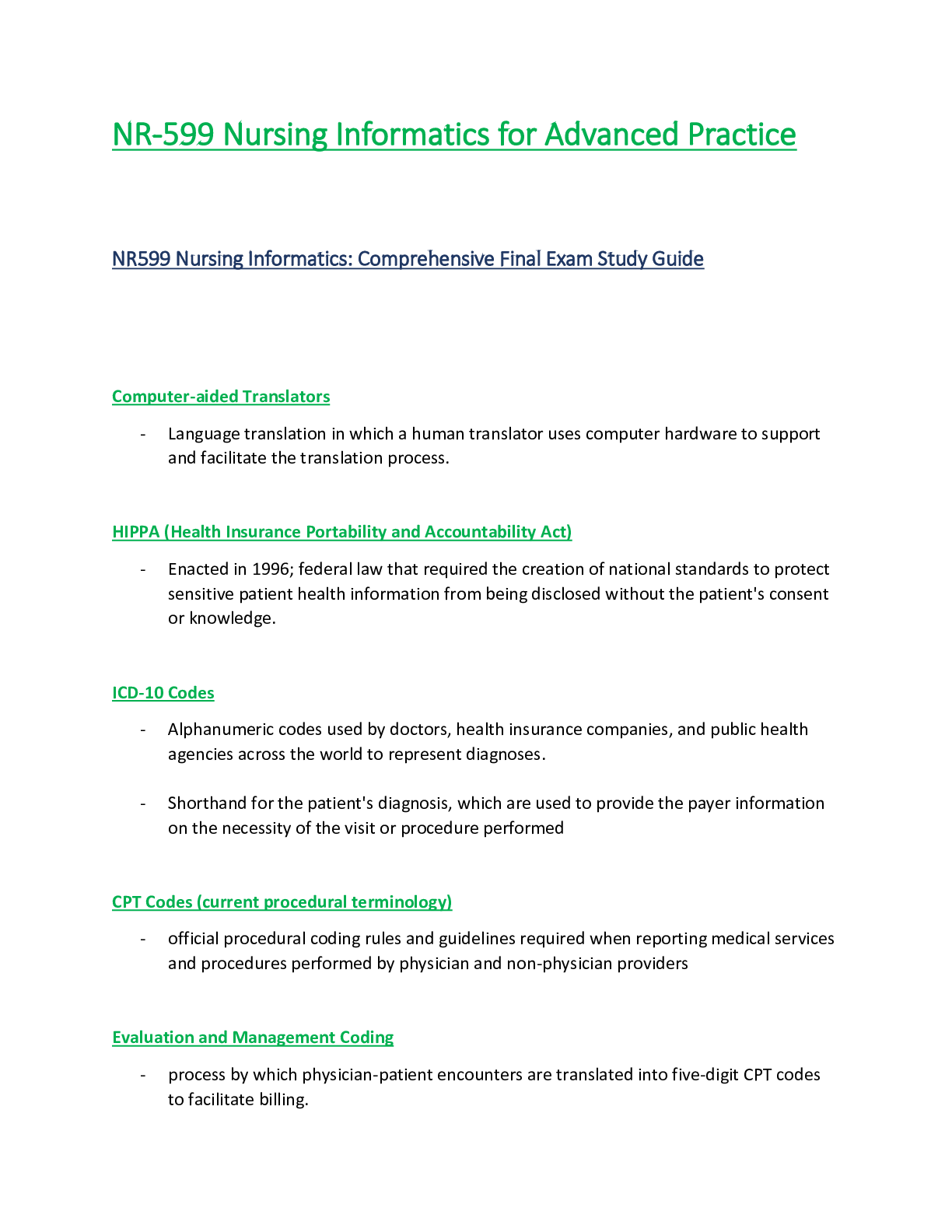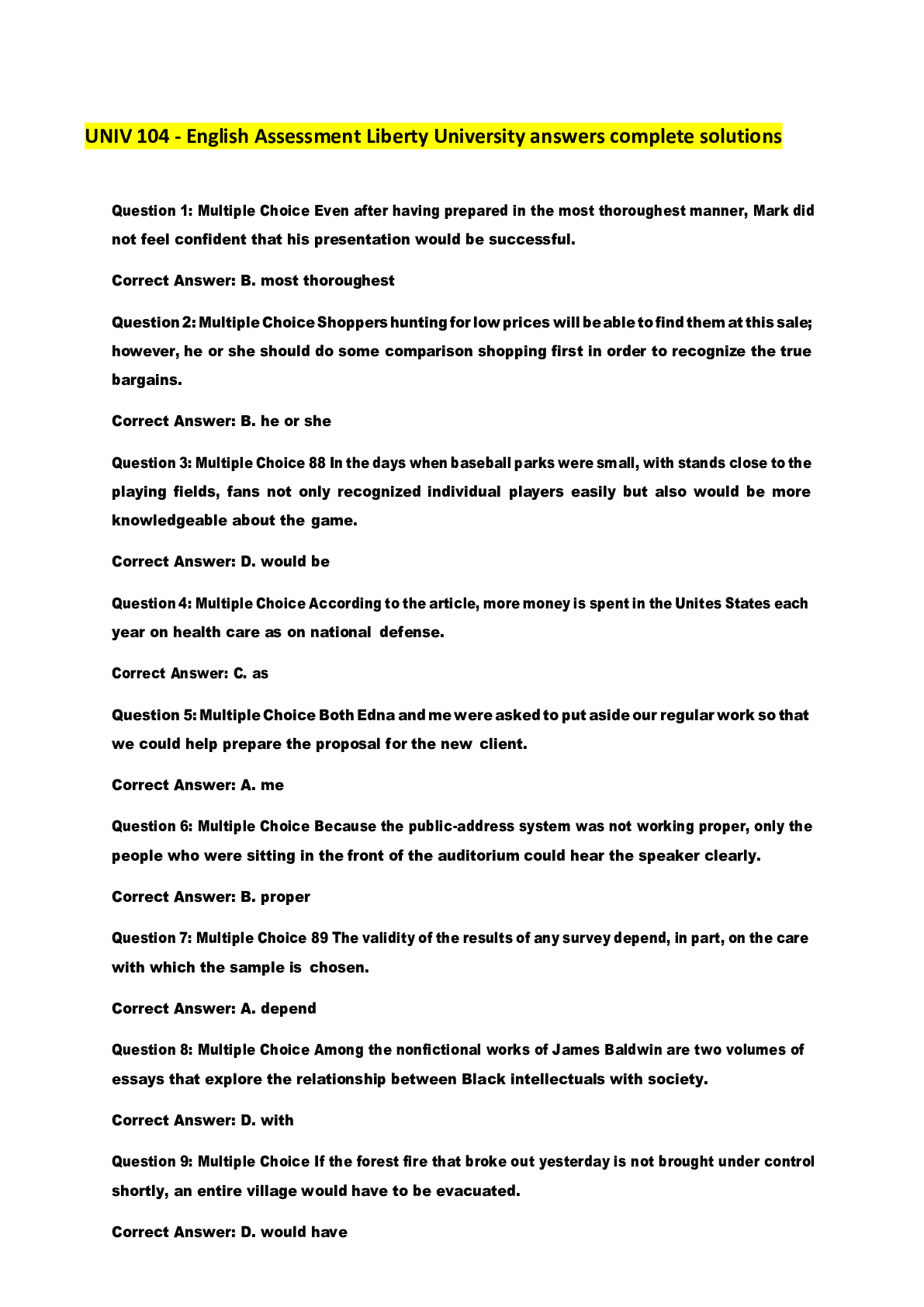*NURSING > STUDY GUIDE > NURS 126 Newborn maternal questions and answers (All)
NURS 126 Newborn maternal questions and answers
Document Content and Description Below
NURS 126 Newborn maternal questions and answers While preparing to provide neonatal care instructions to a primiparous client who gave birth to a term neonate 24 hours ago, what should the nurse ... include in the client's teaching plan? a) Term neonates generally have few creases on the soles of their feet. b) Strawberry hemangiomas—deep, dark red discolorations—require laser therapy for removal. c) Milia are white papules from plugged sebaceous ducts that disappear by age 2 to 4 weeks. d) If erythema toxicum is present, it will be treated with antibiotic therapy. During a home visit to a primiparous client 1 week postpartum who is bottle-feeding her neonate, the client tells the nurse that her mother has suggested that she feed the neonate cereal so he will sleep through the night. What would be the nurse's best response? a) "If cereal is given too early in life, the undigested food can lead to a need for surgery." b) "It is permissible to give the baby cereal if it is thinned with formula." c) "The time for starting cereal varies, so check with your pediatrician." d) "Formula is the food best digested by the baby until about 4 to 6 months of age." While performing a complete assessment of a term neonate, which finding would alert the nurse to notify the health care provider (HCP)? a) prominent xiphoid process b) red reflex in the eyes c) expiratory grunt d) respiratory rate of 45 breaths/min A nurse is about to give a full-term neonate his first bath. How should the nurse proceed? a) Scrub the neonate's skin to remove the vernix caseosa. b) Wash the neonate from feet to head. c) Bathe the neonate only after his vital signs have stabilized. d) Clean the neonate with medicated soap. An alarm signals, indicating that a neonate's security identification band requires attention. The nurse responds immediately and finds that the parents removed the identification bands from the neonate. Which action should the nurse take next? a) Obtain the neonate's footprints and compare them with the footprints obtained at birth. b) Compare the information on the neonate's identification bands with that of the mother's, then reattach the identification bands to one of the neonate's extremities. c) Reprimand the parents for allowing the identification bands to come off. d) Replace the identification bands. After instructing a mother about normal reflexes of term neonates, the nurse determines that the mother understands the instructions when she describes the tonic neck reflex as occurring when the neonate displays which behavior? a) extends and abducts the arms and legs with the toes fanning open b) steps briskly when held upright near a firm, hard surface c) turns head to the left, extends left extremities, and flexes right extremities d) pulls both arms and does not move the chin beyond the point of the elbows While caring for a neonate 2 days after birth, the nurse observes a swelling on the neonate’s head that does not cross the cranial suture line. The nurse should explain to the parents that this will: a) require several surgeries to repair. b) be a normal symptom of a skull fracture that occurred during the birth. c) remain swollen for at least 6 months before receding. d) resolve without treatment by 6 weeks of age. After the birth of her first neonate, a mother asks the nurse about the reddened areas at the nape of the neonate's neck. How should the nurse respond? a) "They're a common congenital abnormality." b) "They're caused by a blockage in the apocrine glands." c) "They're normal and will disappear as the baby's skin thickens." d) "They commonly result from a traumatic delivery." The nurse is teaching the mother of a newborn to develop her baby's sensory system. To further improve the infant's most developed sense, the nurse should instruct the mother to: a) place the newborn about 12 inches (30.5 cm) from maternal face for best sight. b) give infant formula with a sweetened taste to stimulate feeding. c) stroke the newborn's cheek with her nipple to direct the baby's mouth to nipple. d) speak in a high-pitched voice to get the newborn's attention. After teaching the mother about the neonate’s positive Babinski’s reflex, the nurse determines that the mother understands the instructions when she says that a positive Babinski’s reflex indicates which condition? a) immaturity of the central nervous system b) possible spinal cord defect c) injury to the nerves innervating the legs d) possible partial paralysis The client who is breastfeeding asks the nurse if she should supplement breastfeeding with formula feeding. The nurse bases the response on which principle? a) Primarily, water supplements should be used to prevent jaundice. b) More vigorous sucking is needed for a bottle feeding, so supplements should be avoided. c) Formula feeding should be avoided to prevent interfering with the breast milk supply. d) Formula supplements can provide nutrients not found in breast milk. During the assessment, the nurse observes a gray pigmented nevus on the neonate’s buttocks. The nurse documents this as which finding? a) port wine stain b) cafe au lait spots c) Harlequin's sign d) Mongolian spot At 24 hours of age, assessment of the neonate reveals the following: eyes closed, skin pink, no sign of eye movements, heart rate of 120 bpm, and respiratory rate of 35 breaths/min. What is this neonate most likely experiencing? a) first period of reactivity b) drug withdrawal c) a state of deep sleep d) respiratory distress The nurse is to draw a blood sample for glucose testing from a term neonate during the first hour after birth. The nurse should obtain the blood sample from the neonate’s foot near which area? LATERAL ASPECT OF HEEL • Using this area prevents damage to the calcaneus bone, which is located in the middle of the hell. The middle heel is to be avoided bec. Of the increased risk for damaging the calcaneus bone located there. The middle of the foot contains the medial plantar nerve and the medial plantar artery, which could be injured in this site for specimen collection would cause a great deal discomfort for the neonate; therefore it is not the preferred site. The nurse has completed discharge teaching with new parents who will be bottle-feeding their normal term newborn. Which statement by the parents reflects the need for more teaching? a) "Our baby will require feedings through the night for several weeks or months after birth." b) “Our baby should have 1 to 3 soft, formed stools a day.” c) “We should weigh our baby daily to make sure he is gaining weight.” d) “The baby should burp during and after each feeding with no projective vomiting.” After teaching the client about bottle-feeding, which client statement indicates the need for additional teaching? a) “Whole milk is an acceptable alternative to formula once the baby is 4 months old." b) “Bottle-fed babies up to 6 months of age may gain as much as 1 ounce (30 g)/day." c) “Iron-fortified formulas are usually recommended for newborns." d) “Bottle-fed babies will usually regain their birth weight by 10 to 14 days of age." During the initial assessment, the nurse notes that the neonate’s hands and feet appear blue while the neonate’s torso appears pale pink. What should the nurse do next? a) Wrap the neonate in a warm blanket. b) Ask the mother to massage the neonate's hands and feet. c) Keep the neonate in an isolation incubator for at least 2 hours. d) Report the neonate's cyanosis to the primary care provider promptly. After circumcision with a Plastibell, the nurse should instruct the neonate's mother to cleanse the circumcision site with which agent? a) pvidone-iodine solution b) warm water c) diluted hydrogen peroxide d) antibacterial soap After explaining to a primiparous client about the causes of her neonate's cranial molding, which statement by the mother indicates the need for further instruction? a) "The molding will usually disappear in a couple of days." b) "The molding was caused by an overlapping of the baby's cranial bones during my labor." c) "Brain damage may occur if the molding does not resolve quickly." d) "The amount of molding is related to the amount and length of pressure on the head." The client asks the nurse, “How can I tell whether my baby is spitting up or vomiting?” The nurse explains that, in contrast to regurgitated material, vomited material is characterized by: a) a brownish color. b) usually occurring prior to a feeding. c) a curdled appearance. d) one-time occurrence during feeding. A nurse is preparing a neonate for circumcision. Which behavior is the best example of nursing advocacy? a) Promptly returning the neonate to his mother for comfort and bonding after the procedure b) Ensuring that the neonate has had nothing by mouth (NPO) for at least 6 hours before the procedure c) Monitoring the neonate for the excessive bleeding after the procedure d) Recommending the use of analgesia for circumcision As part of the respiratory assessment, a nurse observes the neonate's nares for patency and mucus. The information obtained from this assessment is important because: a) problems with nasal patency may cause flaring. b) a deviated septum will interfere with breathing. c) nasal patency is required for adequate feeding. d) neonates are obligate nose breathers. A nurse is assessing a 1-hour-old neonate in the special care nursery. Which assessment finding indicates a metabolic response to cold stress? a) Hyperglycemia b) Hypertension c) Arrhythmia d) Hypoglycemia When assessing a neonate's temperature with a disposable digital thermometer, in which location should the nurse place the thermometer? a) under the neonate's arm b) into the neonate's ear c) under the neonate's tongue d) into the neonate's rectum While assessing a 2-hour-old neonate, a nurse observes that the neonate has acrocyanosis. Which nursing action should the nurse perform at this time? a) Take the neonate's temperature immediately according to hospital policy. b) Notify the physician that a cardiac consult is needed. c) Do nothing — acrocyanosis is normal in the neonate. d) Activate the code emergency response system. The triage nurse in the pediatrician’s office returns a call to a mother who is breastfeeding her 4-day-old infant. The mother is concerned about the yellow seedy stool that has developed since discharge home. What is the best reply by the nurse? a) "Soft and seedy unformed stools with each feeding are normal for this age and will continue through breastfeeding." b) "The stool results from the gassy food eaten by the mother. Refrain from eating these foods while breastfeeding." c) "The stool will transition into a soft, brown, formed stool within a few days and is appropriate for breastfeeding." d) "This type of stool indicates the infant may have diarrhea and should be seen in the office today." When assessing a neonate, the nurse observes a vaguely outlined area of scalp edema that is most likely caput succedaneum. What is the most appropriate nursing action based on this finding? a) Note the finding on the assessment record. b) Call the physician and inform him of the finding. c) Keep the neonate on nothing-by-mouth status and observe for seizures. d) Tell the parents this is a normal finding for a neonate who was breech. While a mother is feeding her full-term neonate 1 hour after birth, she asks the nurse, “What are these white dots in my baby’s mouth? I tried to wash them out, but they are still there.” After assessing the neonate’s mouth, the nurse explains that these spots indicate which condition? a) Epstein's pearls b) Koplik's spots c) thrush curds d) precocious teeth A primiparous woman has recently given birth to a term infant. Priority teaching for the patient includes information on: a) infant bathing. b) infant sleep-wake cycles. c) breastfeeding. d) sudden infant death syndrome (SIDS). Which action is most appropriate when noting small, shiny white specks on the neonate’s gums and hard palate during assessment? a) Try to remove the specks with a wet washcloth. b) Attempt to obtain a sterile specimen on a swab. c) Continue monitoring because these spots are normal. d) Place the neonate in an isolation area. While the nurse is conducting a teaching session on breast-feeding, a client asks why she should put her newborn to the breast within the first 30 minutes of birth. The nurse's best response will be: a) "Your breasts will be firm and filled with colostrum at this time." b) "The neonate will be responsive and eager to suck at this time." c) "Breast-feeding will inhibit prolactin production." d) "Breast-feeding will prevent the newborn from heat loss." A neonate born 2 hours ago has just arrived in the nursery. Which nursing measure will prevent the neonate from losing heat by evaporation? a) Keeping him away from drafts b) Drying him thoroughly after a bath c) Putting a cap on his head d) Putting a blanket between him and cold surfaces Which of the following assessments would indicate an Apgar score of 8 for a neonate immediately after birth? a) Some muscle tone in the arms and legs, bluish hands and feet b) Heart rate of less than 100 beats/minute c) Weak cry, heart rate of less than 100 beats/minute, and some muscle tone. d) A negative Babinski reflex A new mother is concerned because her breast-feeding neonate wants to "nurse all the time." Which response best indicates the normal neonate's breast-feeding behavior? a) "Don't worry; your baby is an aggressive feeder and needs a lot of sucking satisfaction." b) "Breast milk is ideal for your baby, so his stomach will digest it quickly, requiring more feedings." c) "It seems as if your baby is hungry. Why don't you provide your baby with formula after the feeding to make sure he's getting enough nourishment?" d) "Let me call the lactation consultant to make sure that your baby is feeding properly." A neonate circumcised with a Plastibell 1 hour ago is brought to his mother for feeding. What should the nurse instruct the mother to do? a) Place petroleum jelly over the site every 2 hours. b) Remove the petroleum jelly gauze in 24 hours. c) Read a pamphlet about circumcision care. d) Tell the nurse when the neonate voids. A mother is concerned that her neonate, who was born without complications at 38 weeks, isn't eating enough and will lose too much weight. The mother states, "He only breast-feeds for about 3 minutes on one side." Which instruction should the nurse provide to this mother? a) "It's important that he doesn't lose too much weight. We should start him on formula after each feeding." b) "I understand your concern, but he has stored nutrients before birth just for this reason." c) "I am concerned, too, and will notify the pediatrician immediately." d) "Don't worry. When he's hungry, he'll eat. You'll see; it will be fine." A client returns to the postnatal ward with her 3-week-old infant. Which statement by the client would prompt the nurse to document "Imbalanced nutrition less than body requirements related to inadequate intake"? a) "The baby wets 10 to 12 diapers in 24 hours." b) "The baby does not burp after a feeding." c) The baby does not exhibit a steady weight gain." d) "The baby shows a desire to be fed every 3 to 4 hours." A newly hired nurse on unit orientation prepares to administer vitamin K to a neonate. The nurse draws up 1 mg of vitamin K and prepares to administer a subcutaneous injection in the left, lateral anterior thigh. Which action by the nurse preceptor is best? a) Stop the nurse and have her reevaluate her injection techniques. b) Stop the nurse and instruct her to administer the vitamin K using the Z-track method. * Vitamin K may be given through IM and SQ so Ztrack is not needed c) Distract the neonate by talking to her in a calm voice. d) Praise the nurse for accurately preparing to administer the injection. While caring for a healthy female neonate, the nurse notices red stains on the diaper after the baby voids. Which action should the nurse take next? a) Encourage the mother to feed the baby to decrease dehydration. b) Check the baby's urine for hematuria. c) Call the physician to report the problem. d) Do nothing because this is normal. When developing the plan of care for a neonate, what measure should the nurse include to prevent heat loss from conduction? [Show More]
Last updated: 1 year ago
Preview 1 out of 10 pages
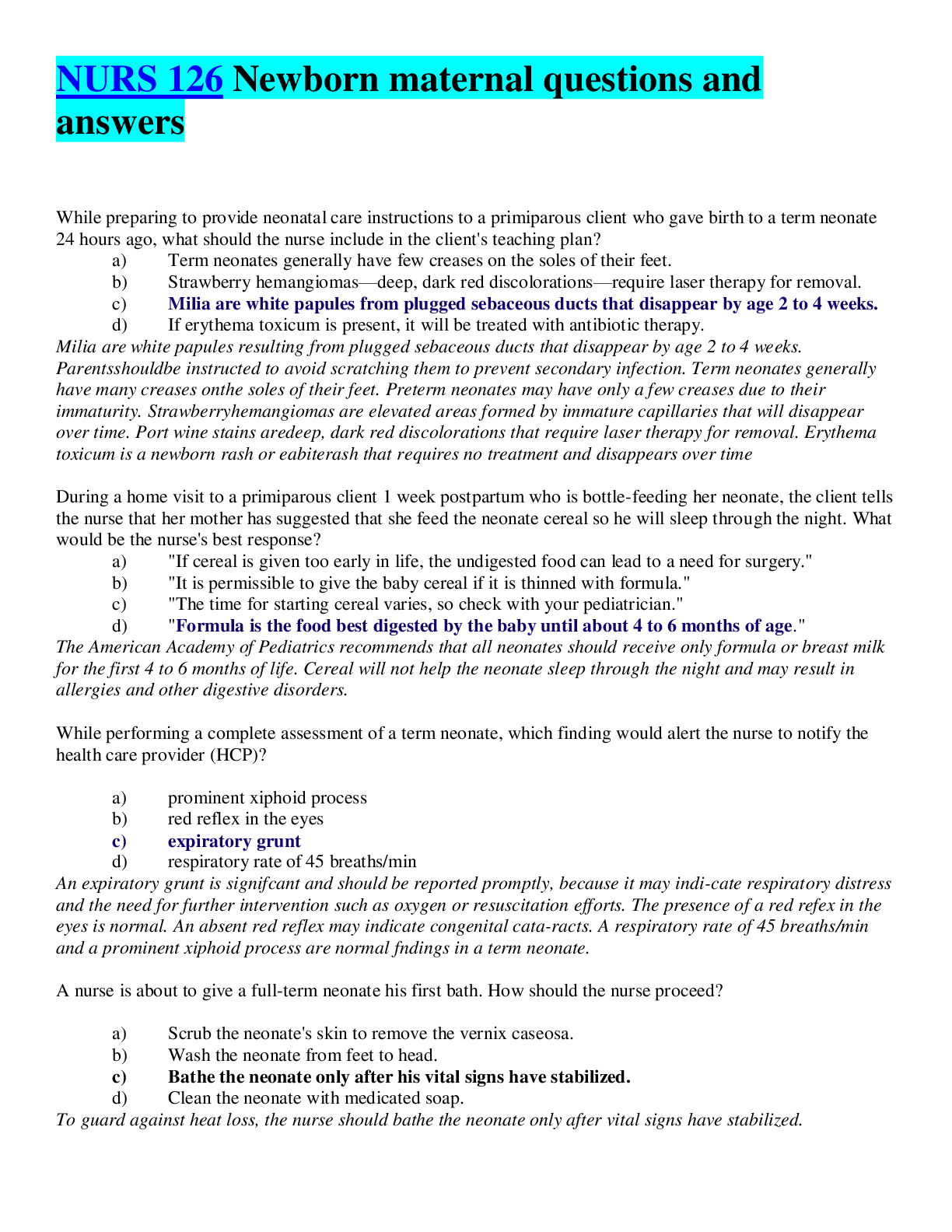
Reviews( 0 )
Document information
Connected school, study & course
About the document
Uploaded On
Nov 03, 2020
Number of pages
10
Written in
Additional information
This document has been written for:
Uploaded
Nov 03, 2020
Downloads
0
Views
103

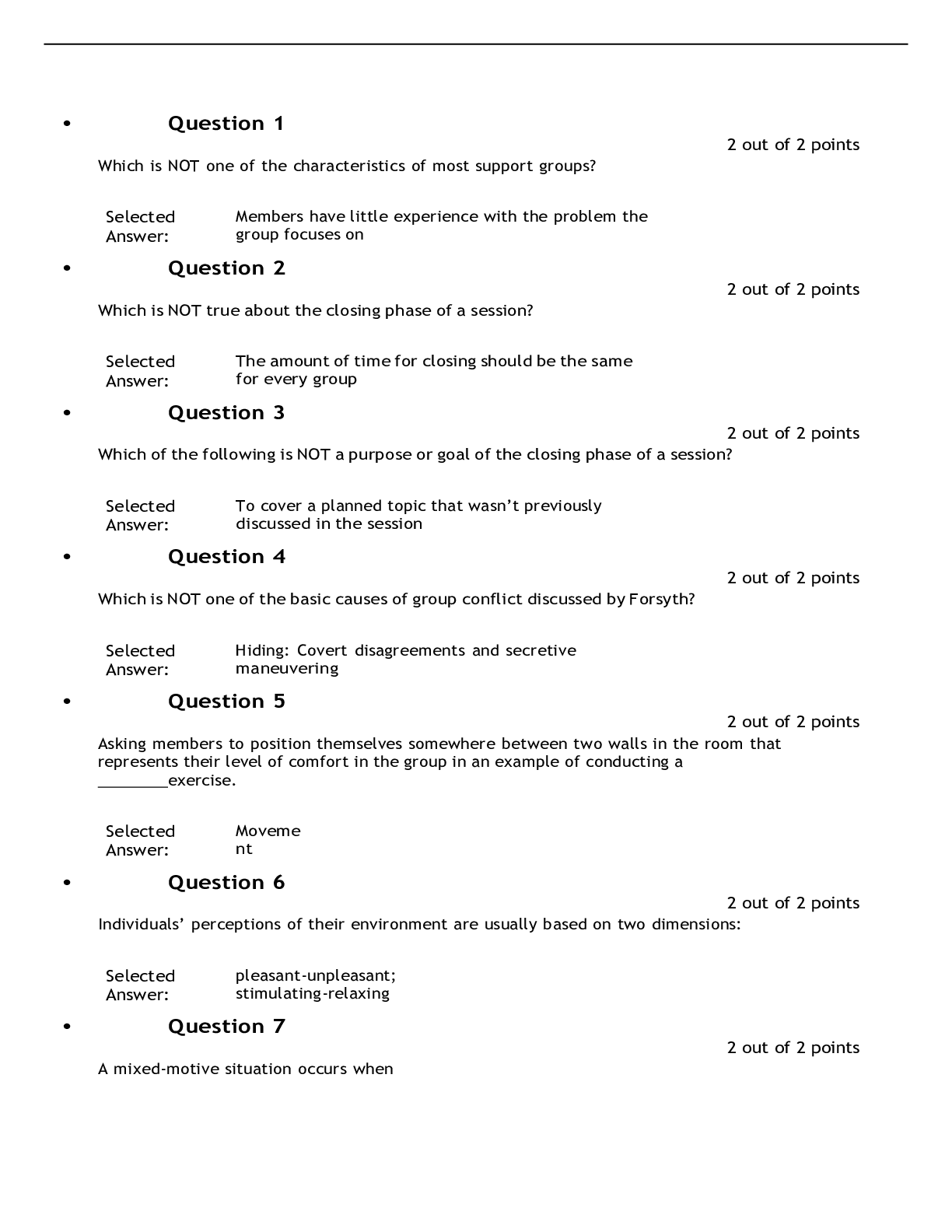
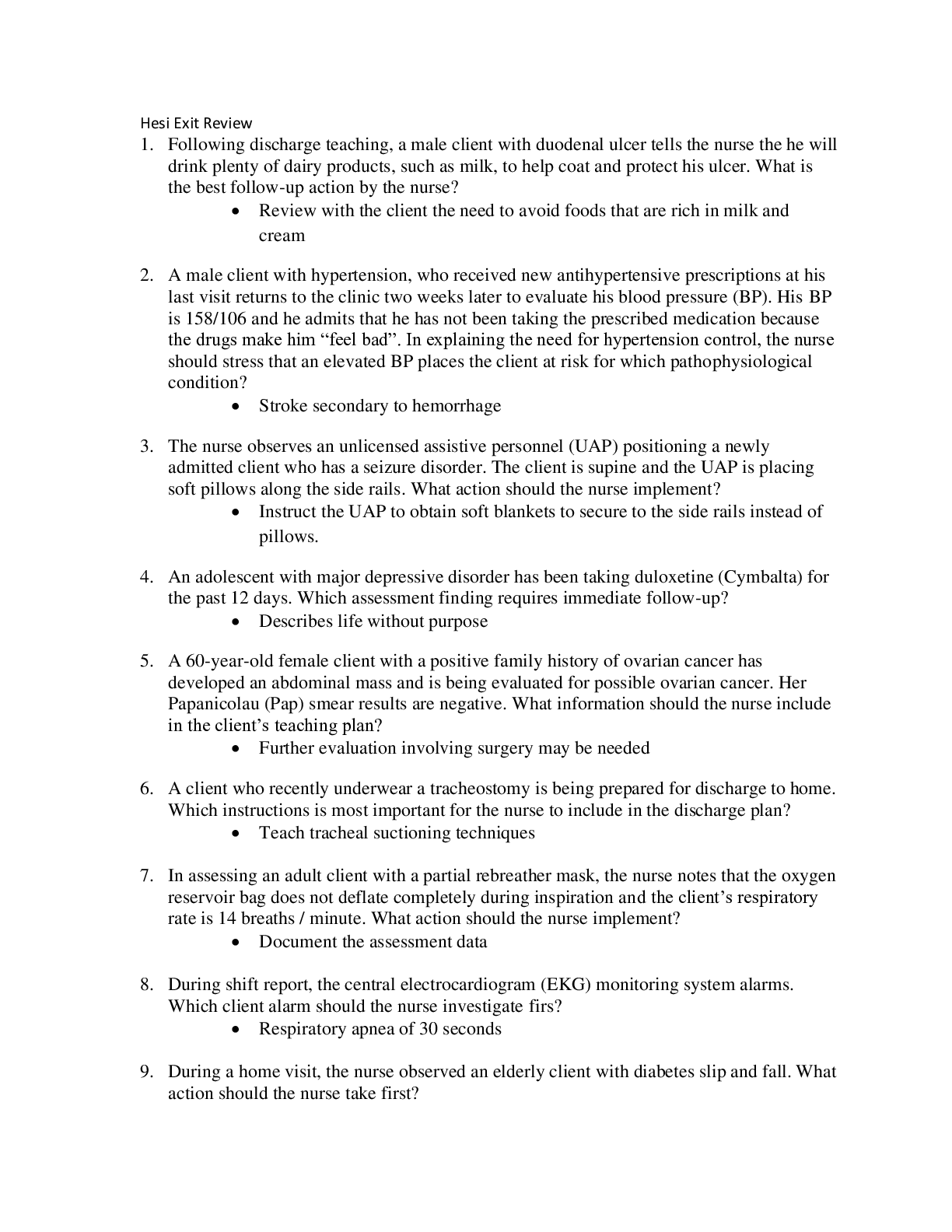
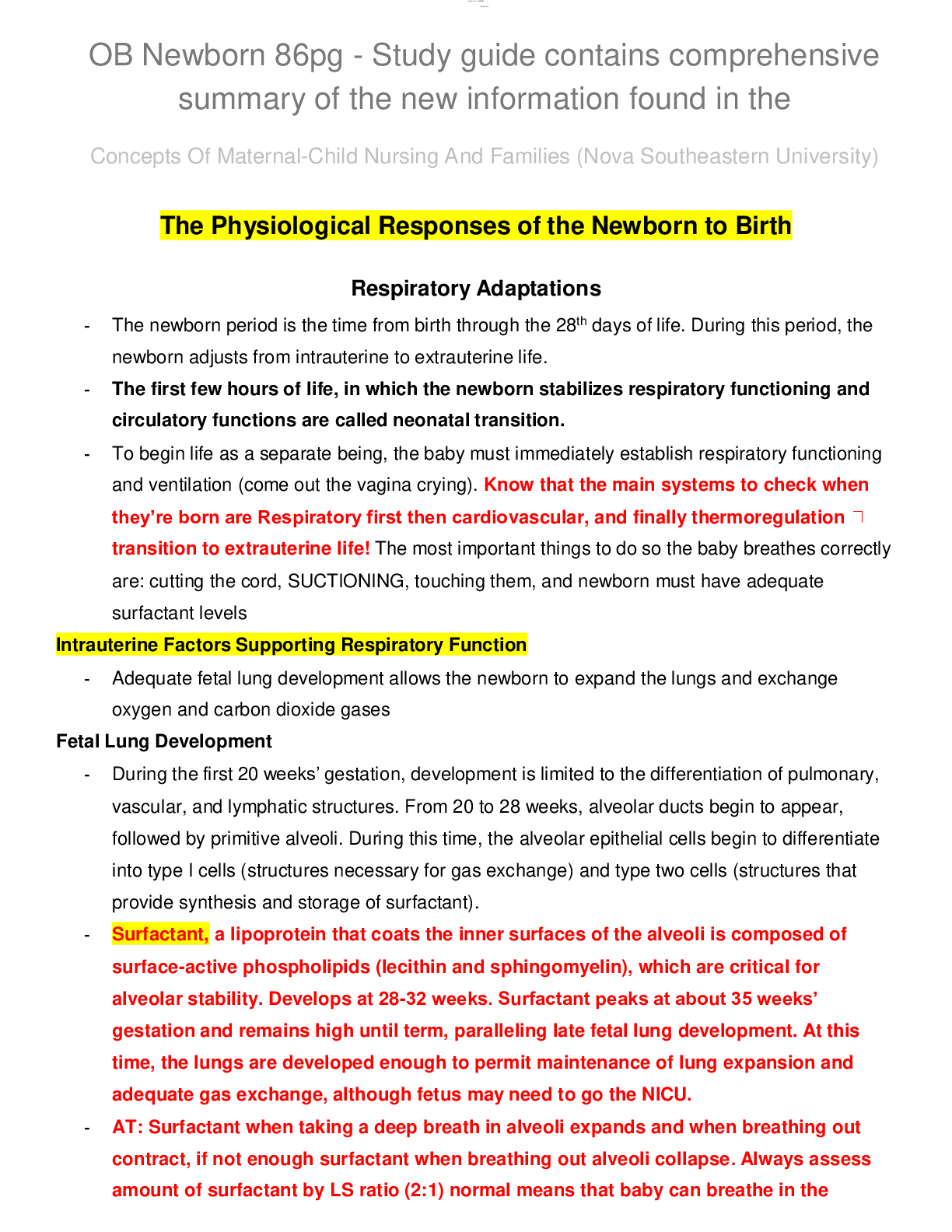
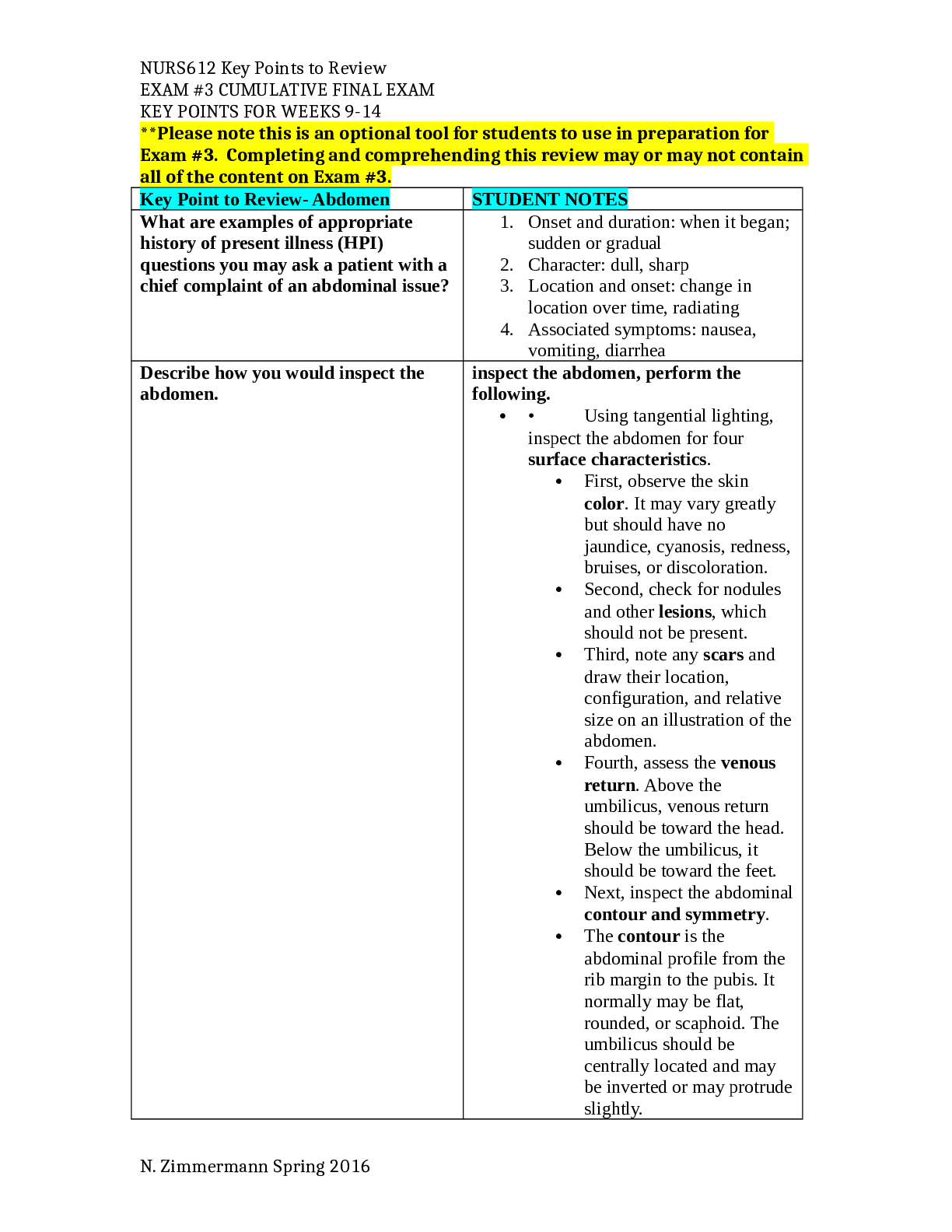
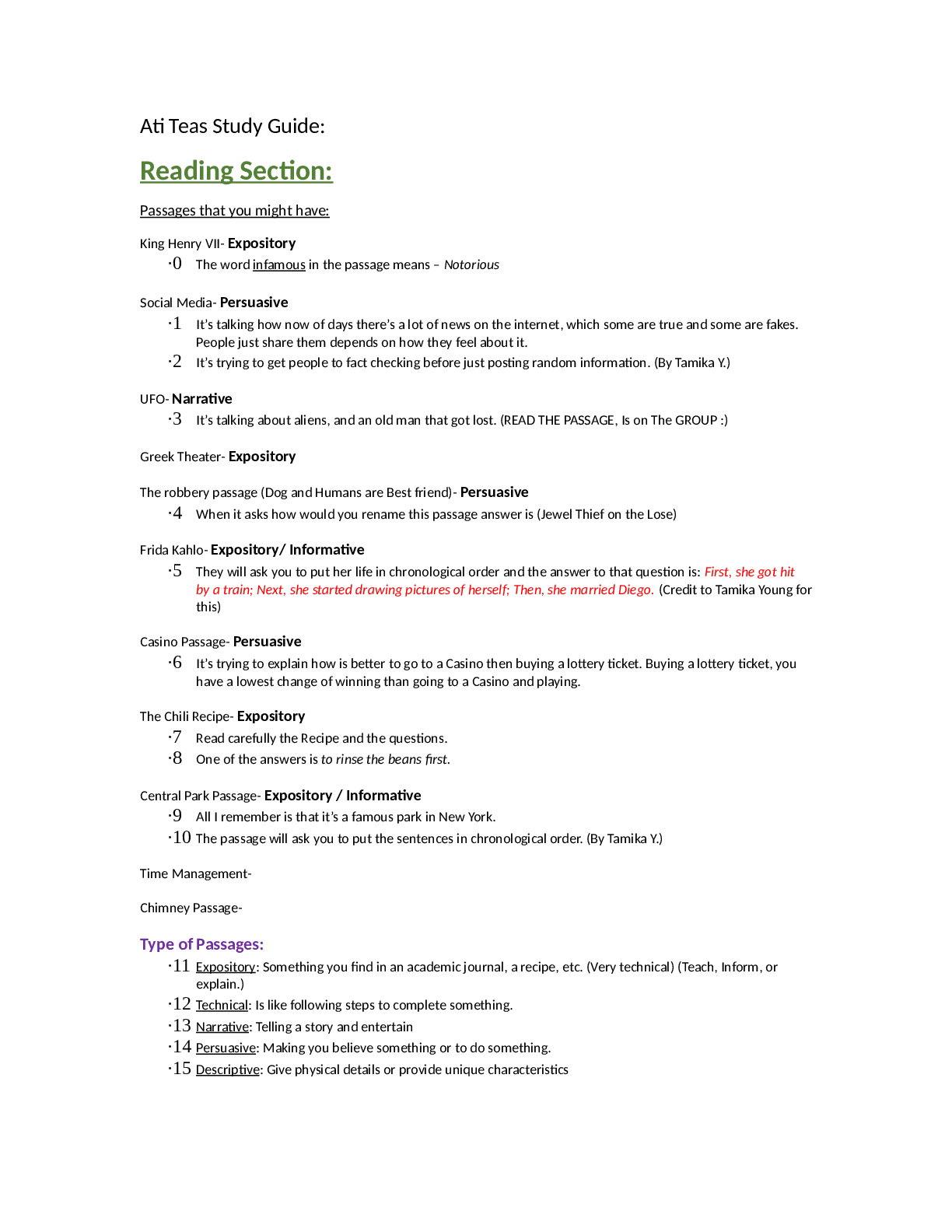
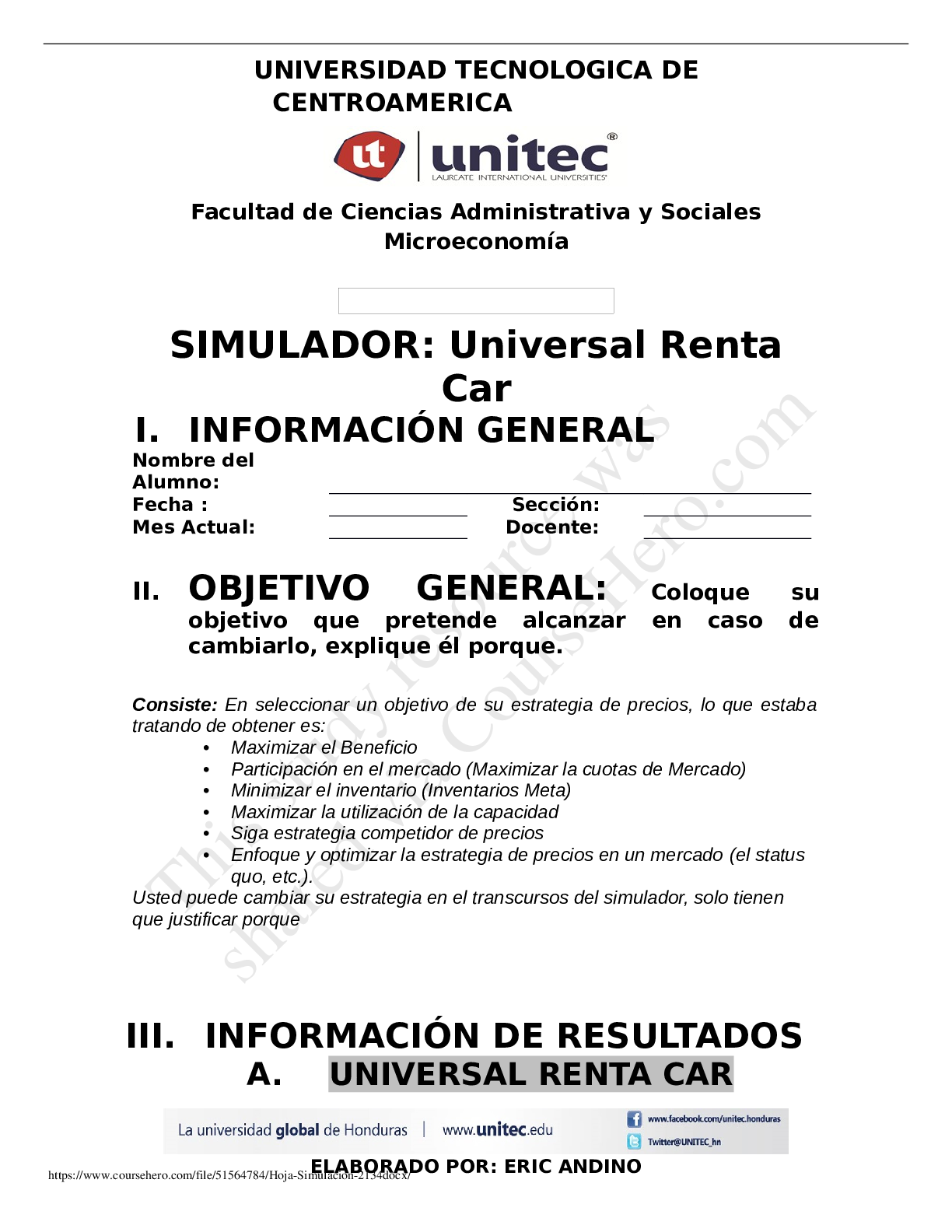
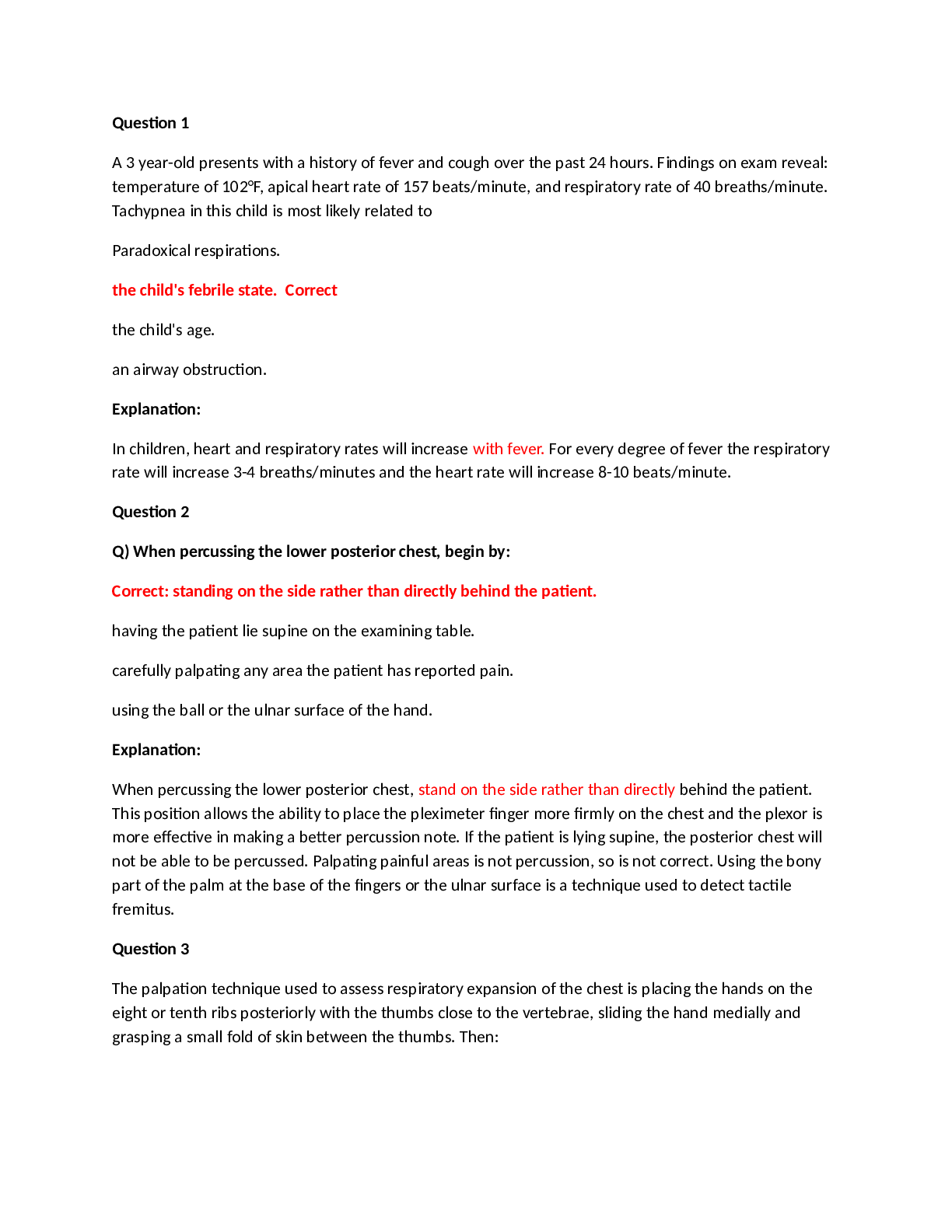
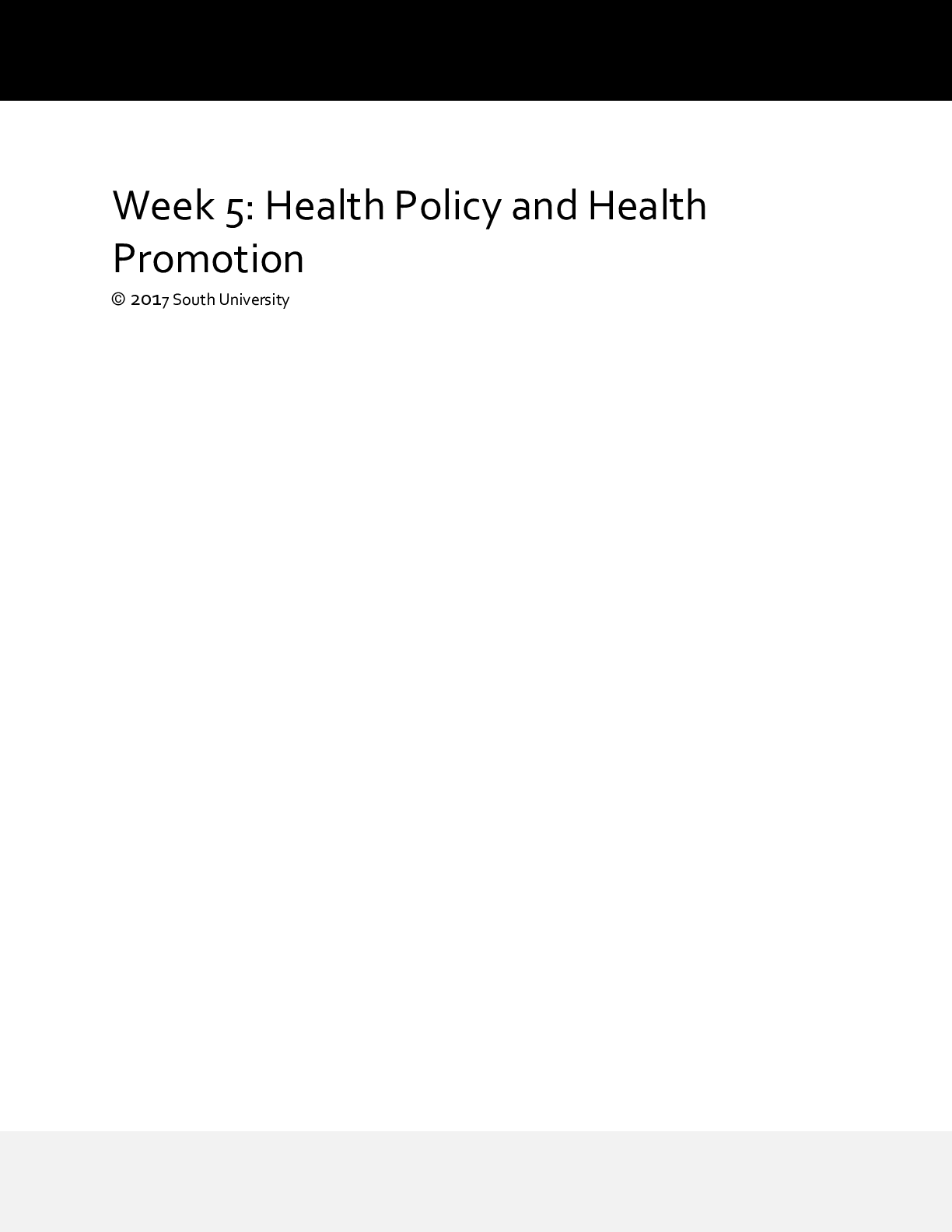
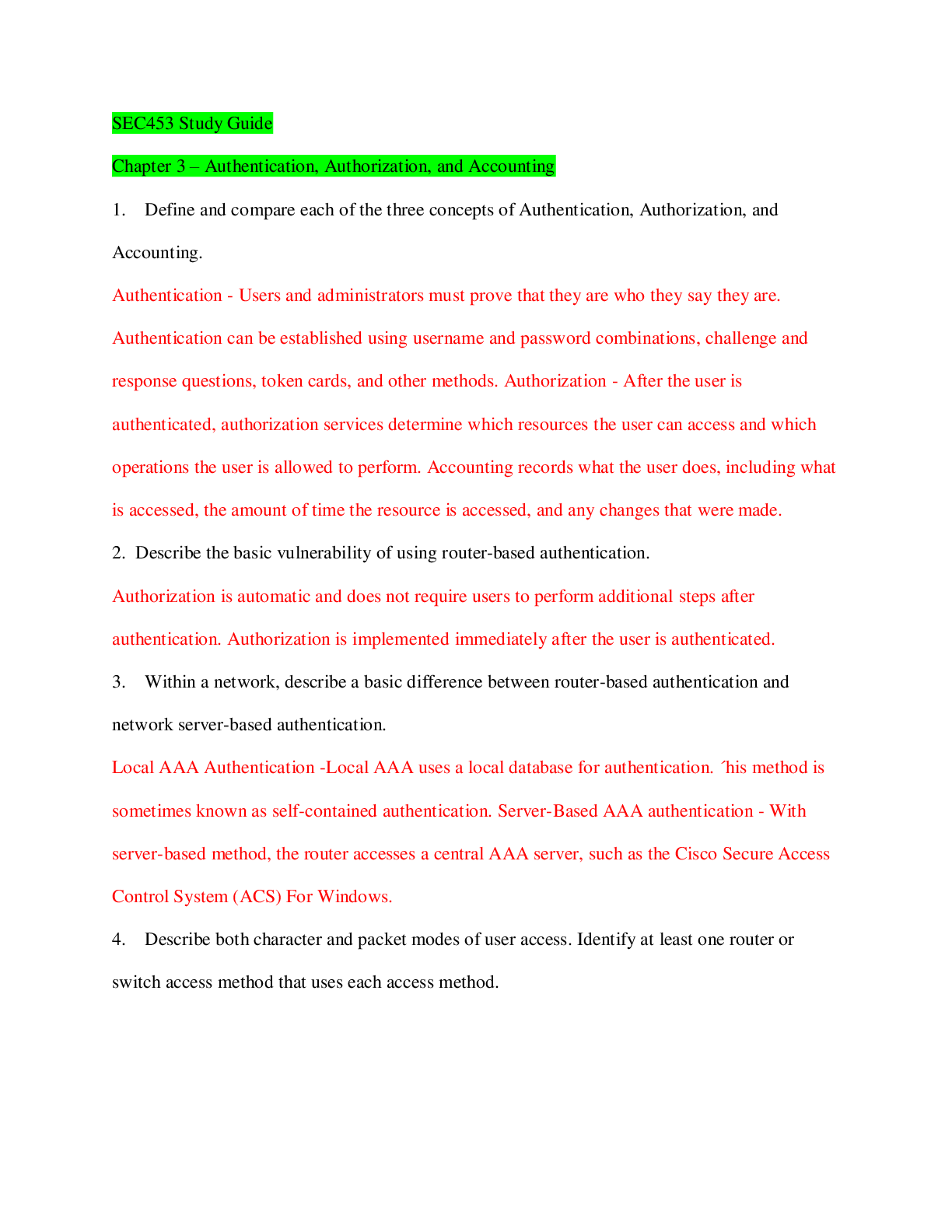
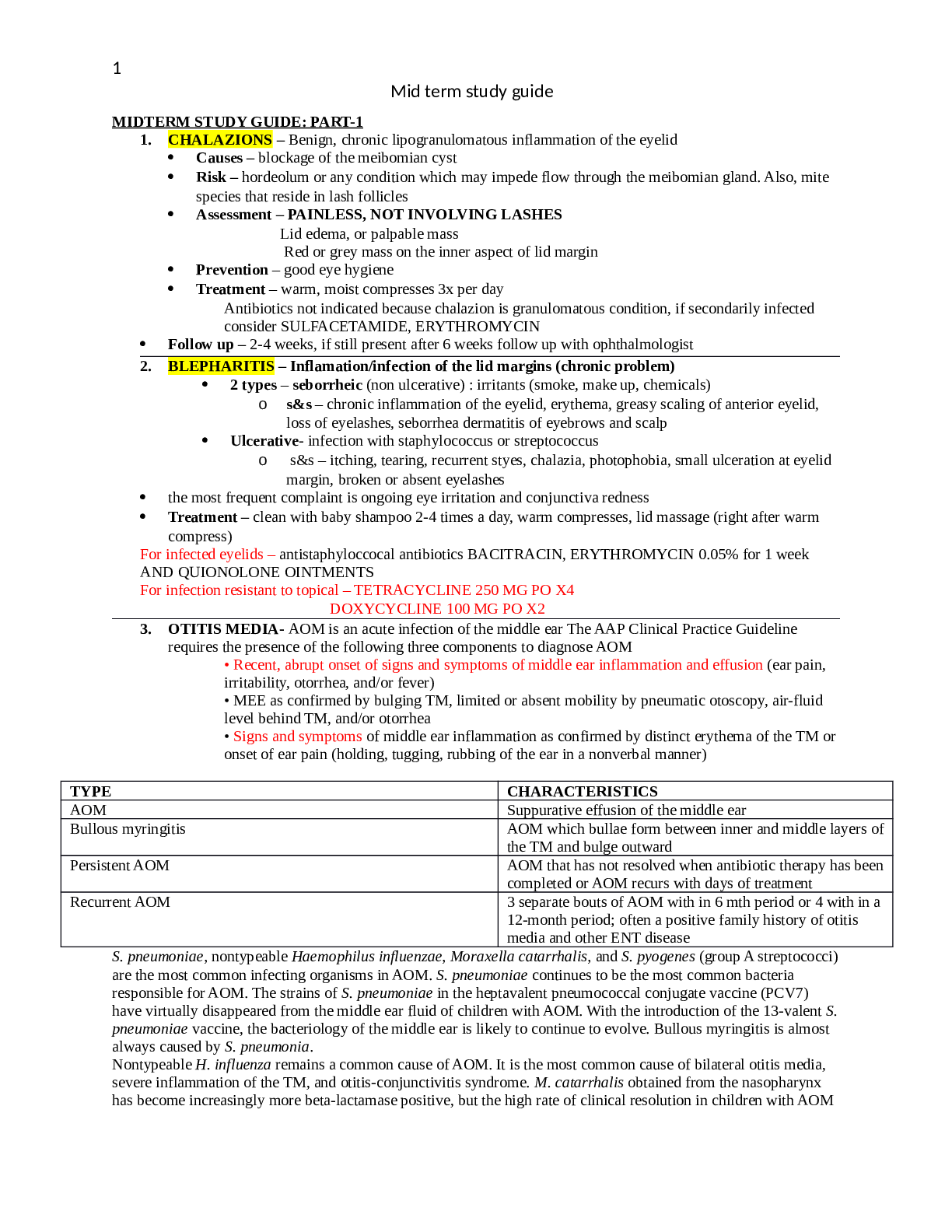
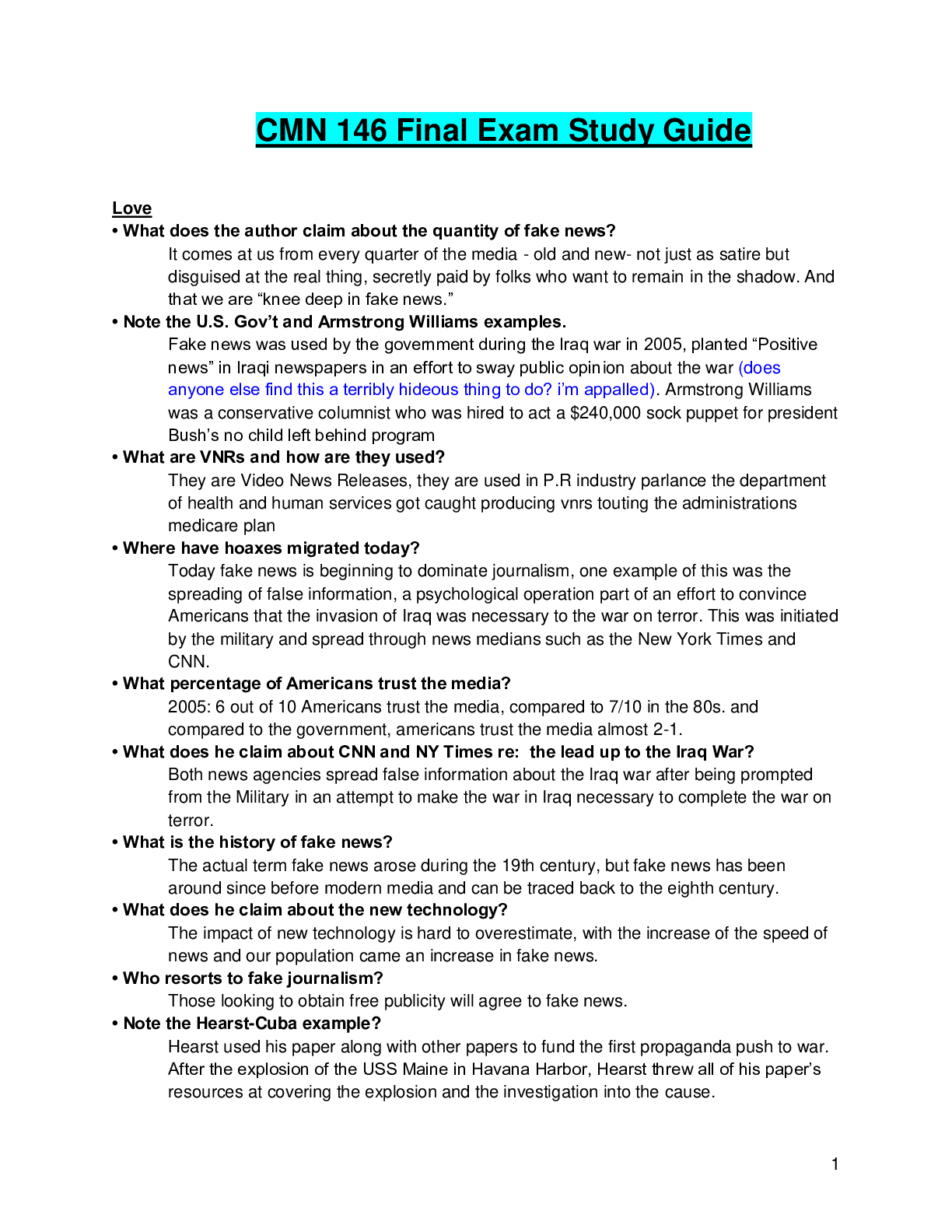
 (2).png)
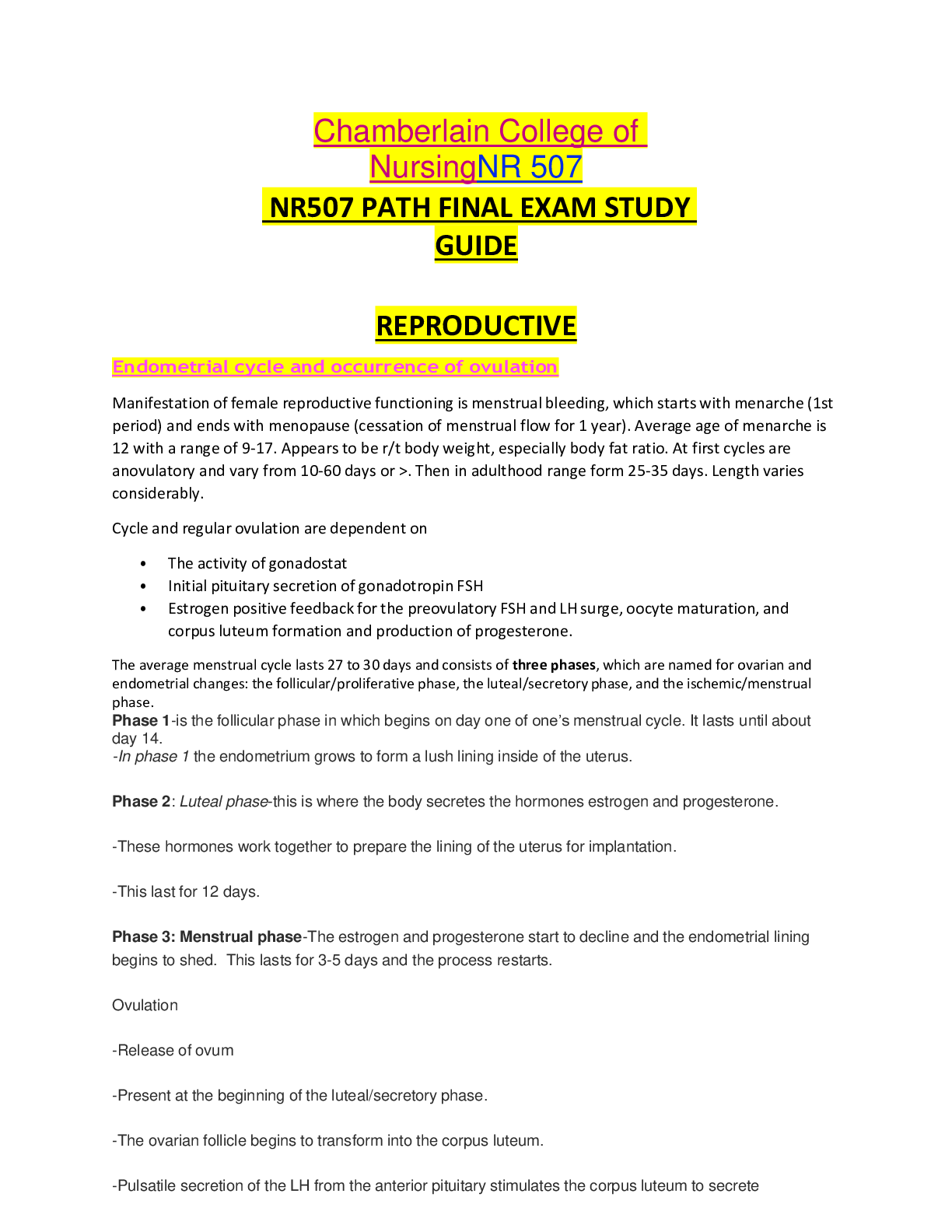
.png)
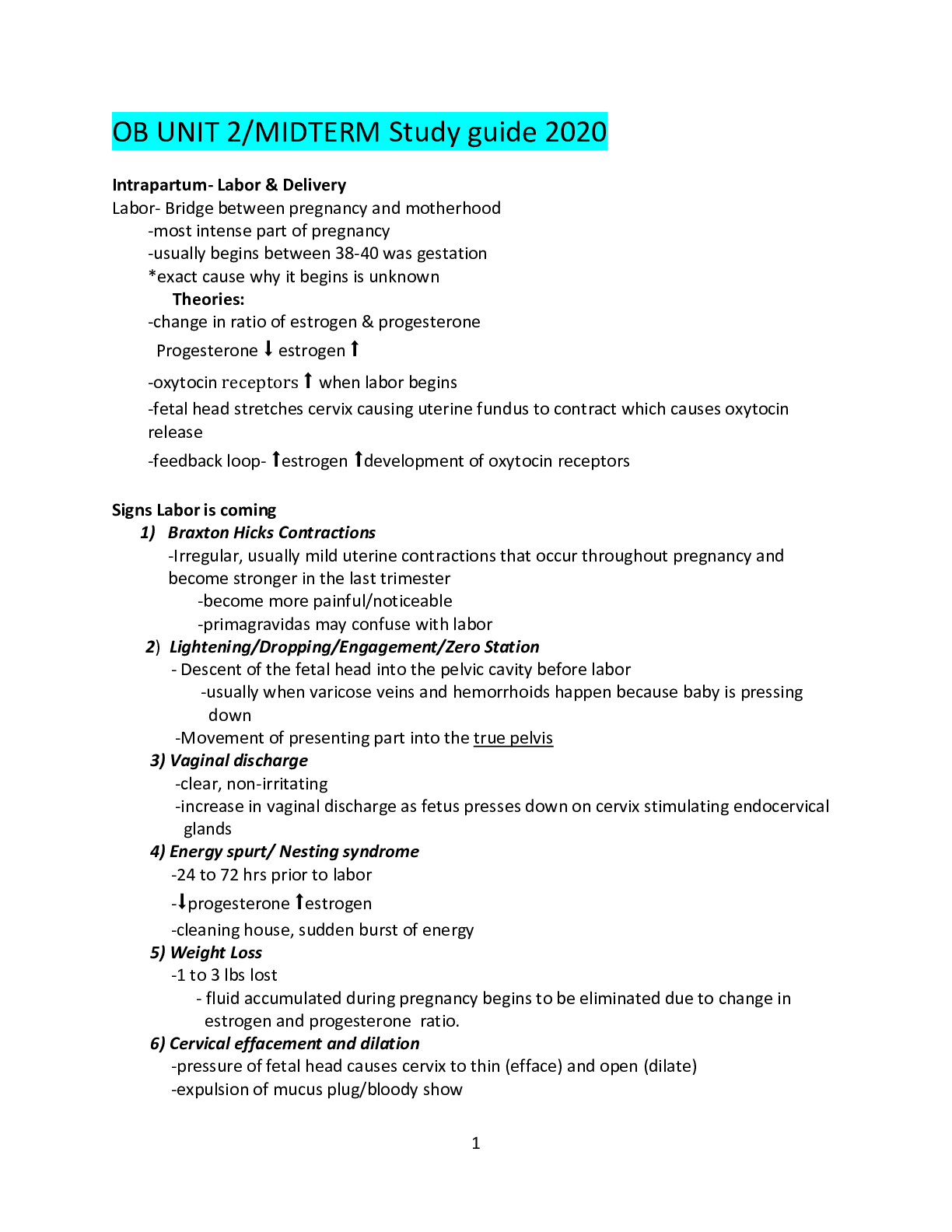
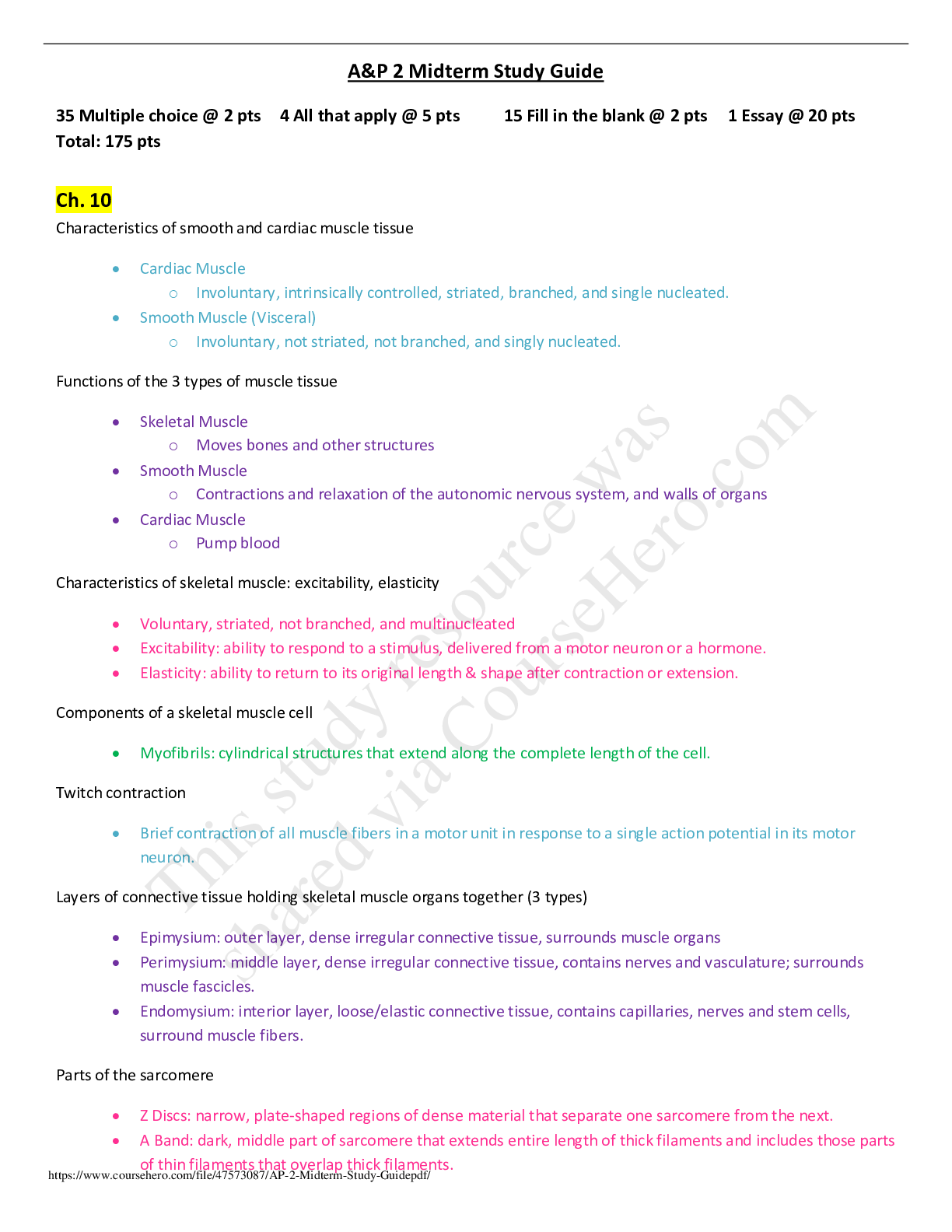
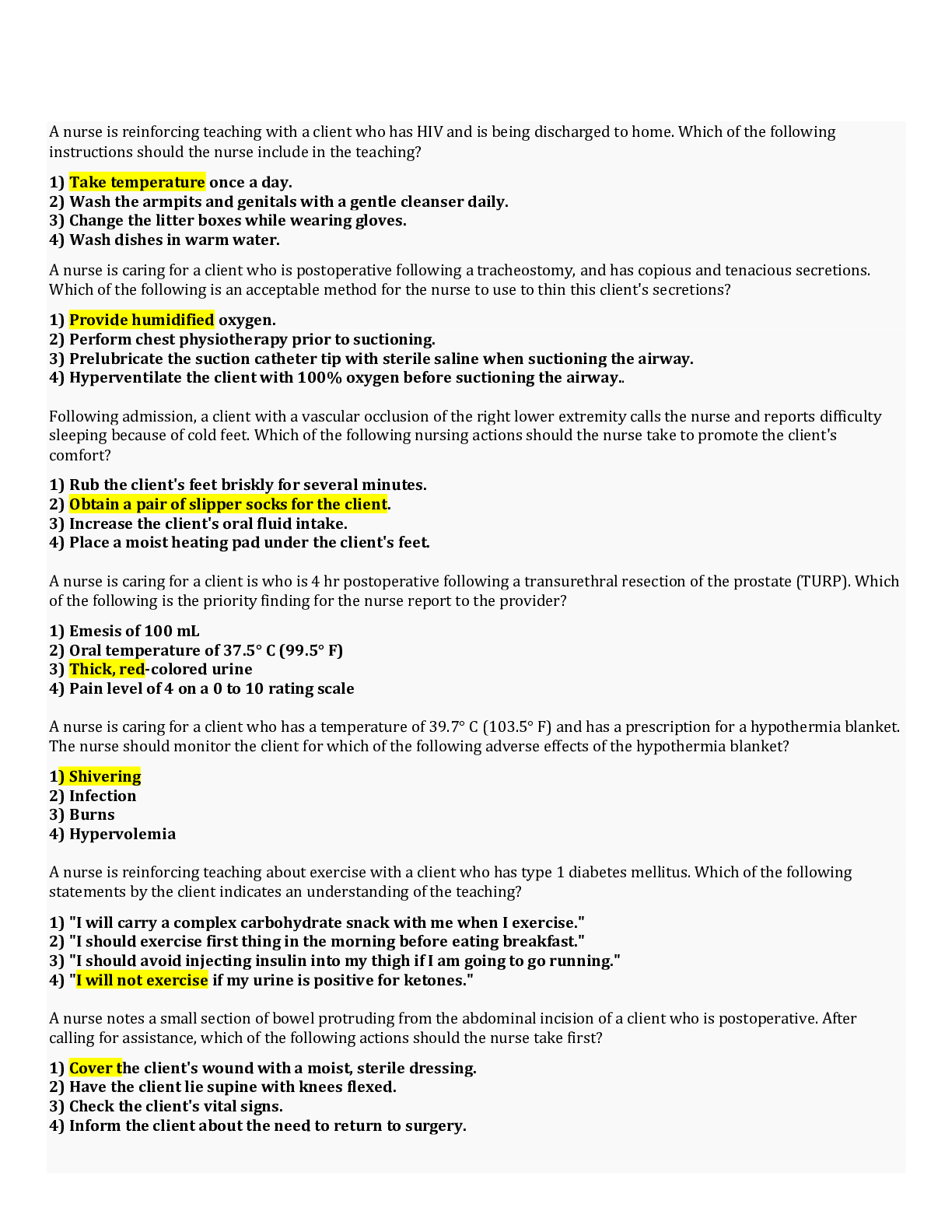

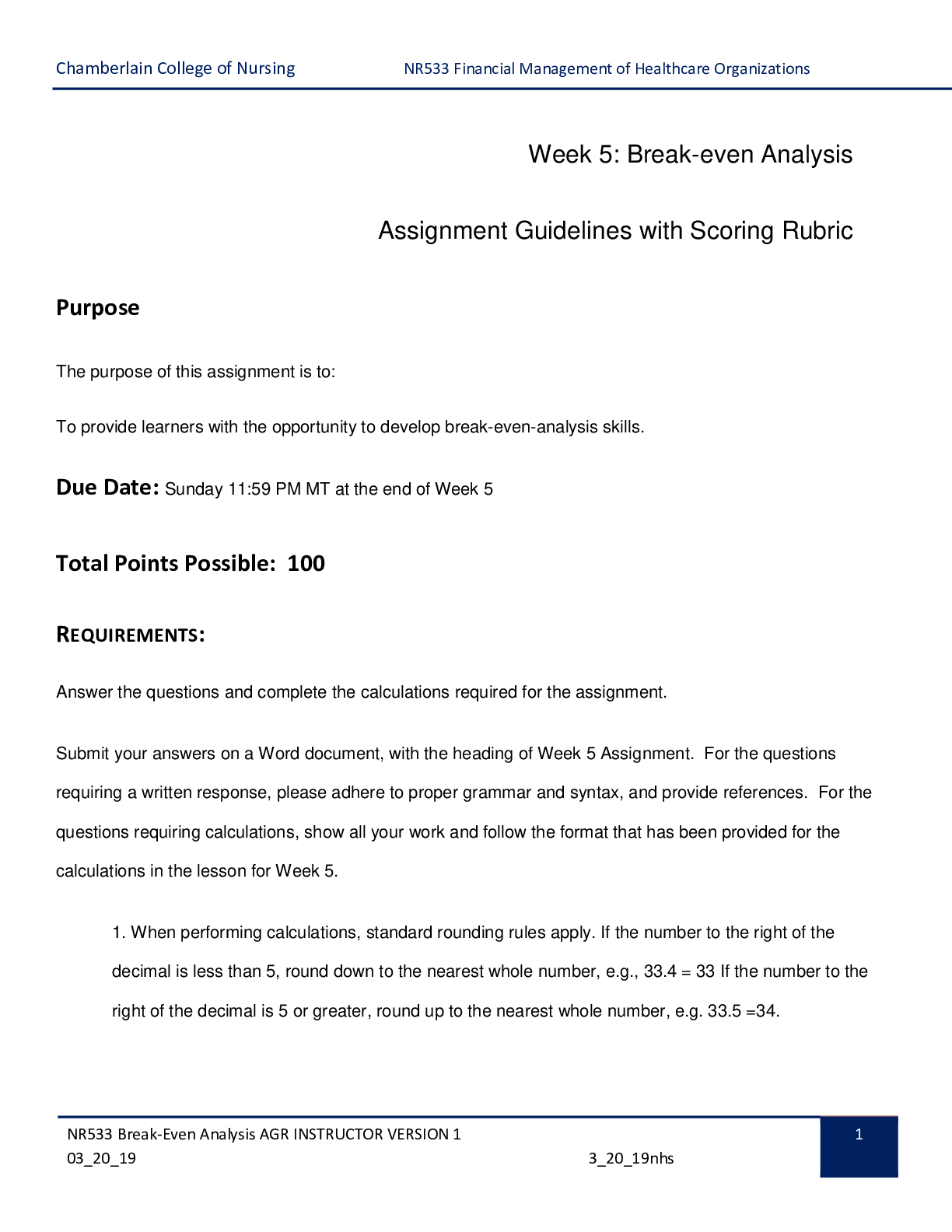

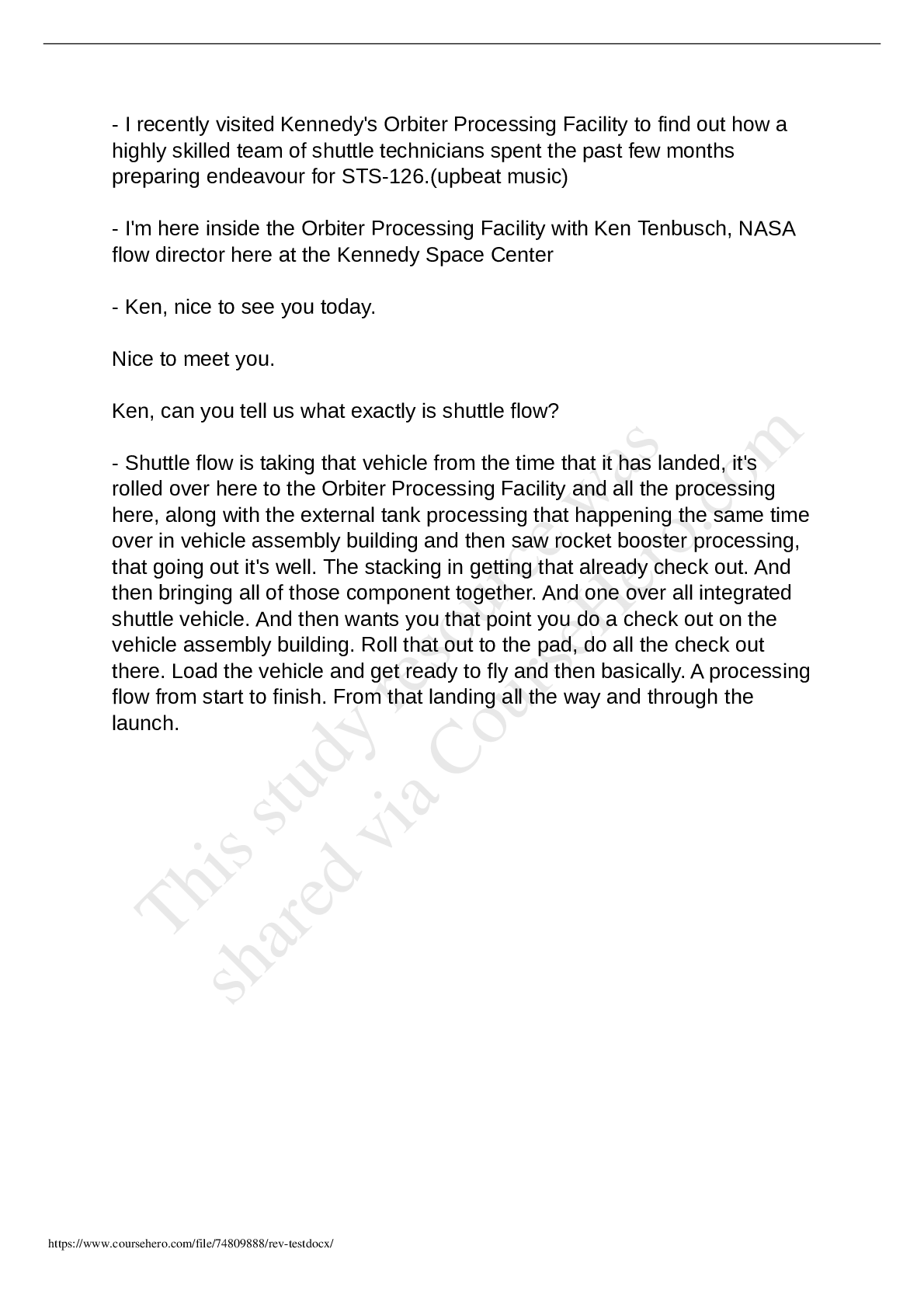
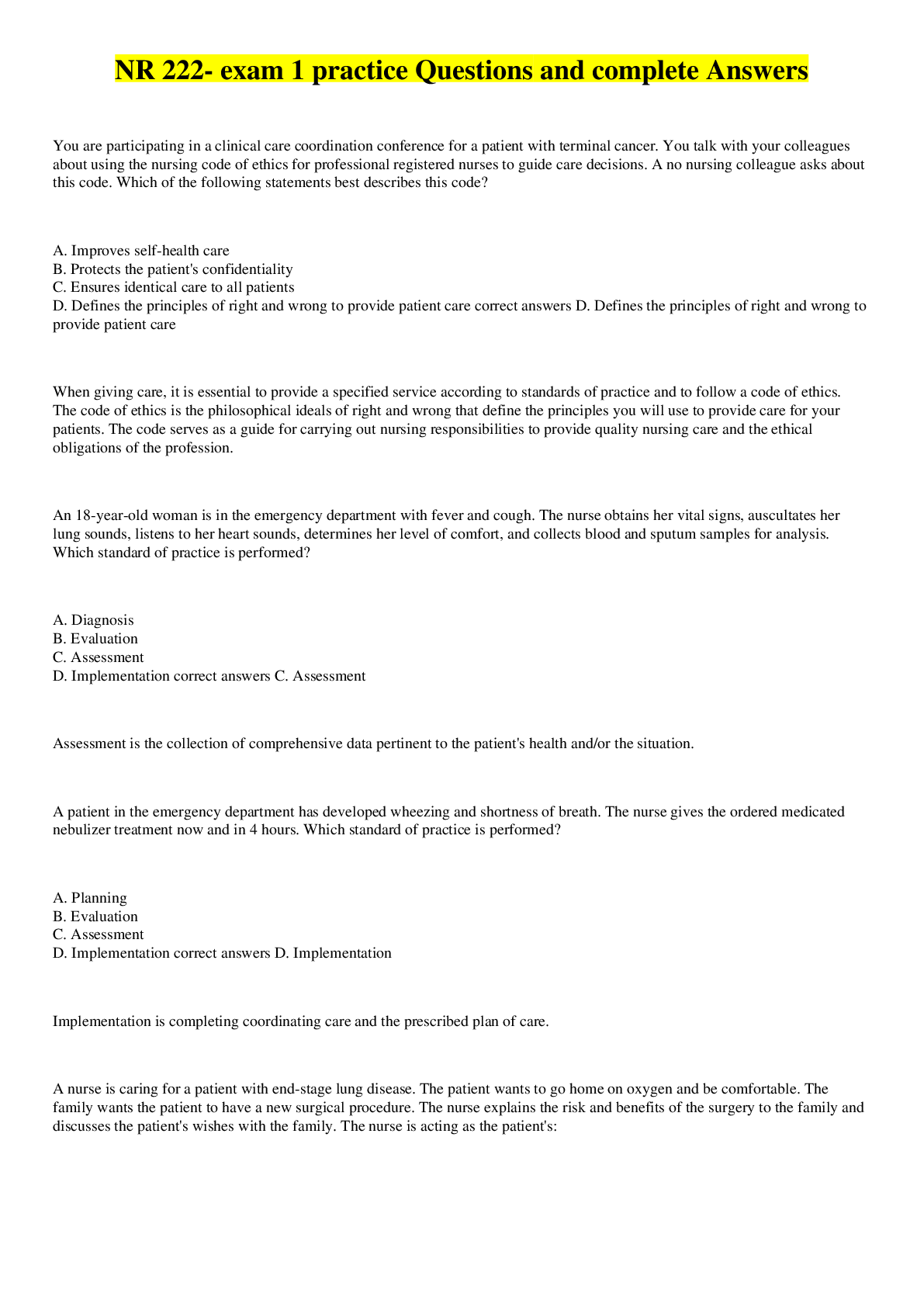
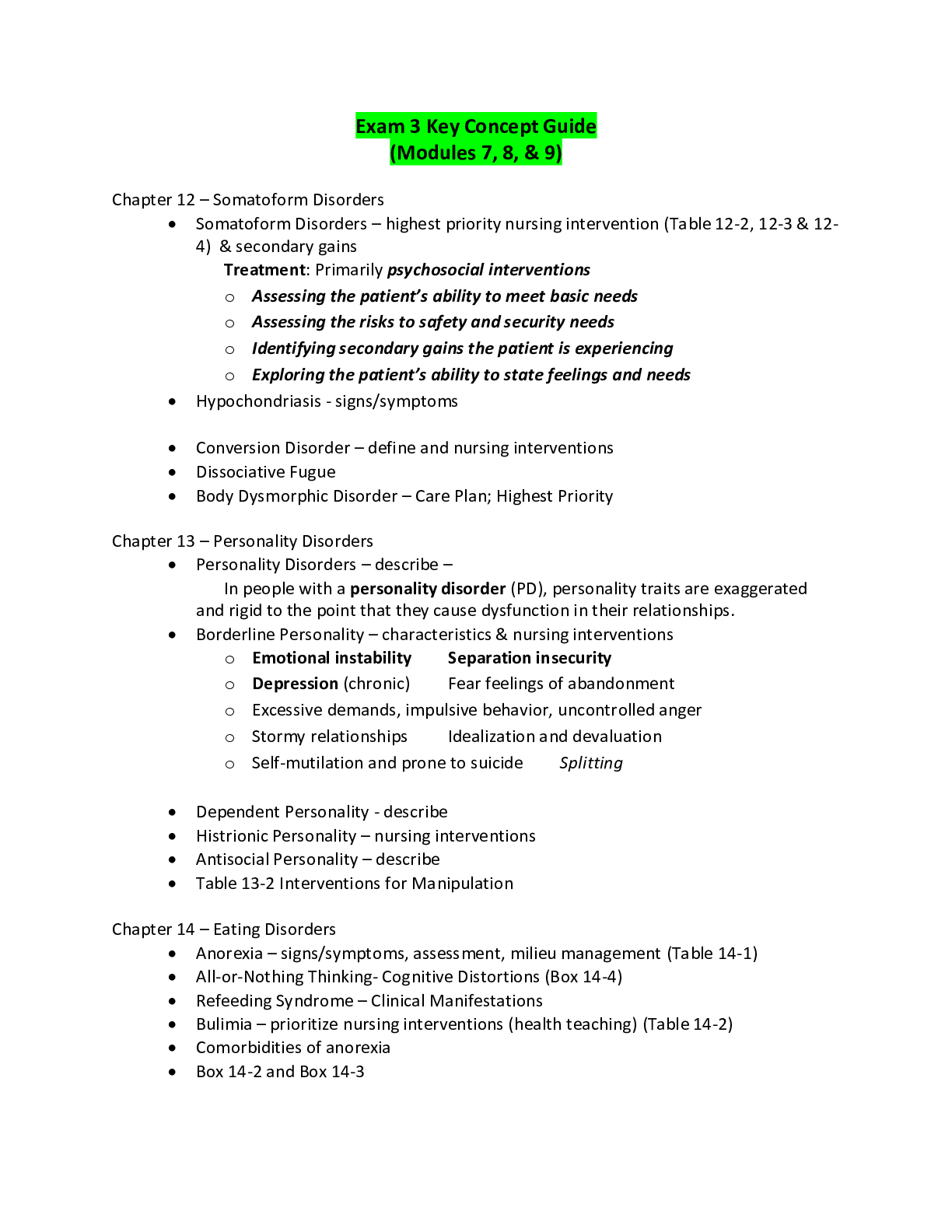
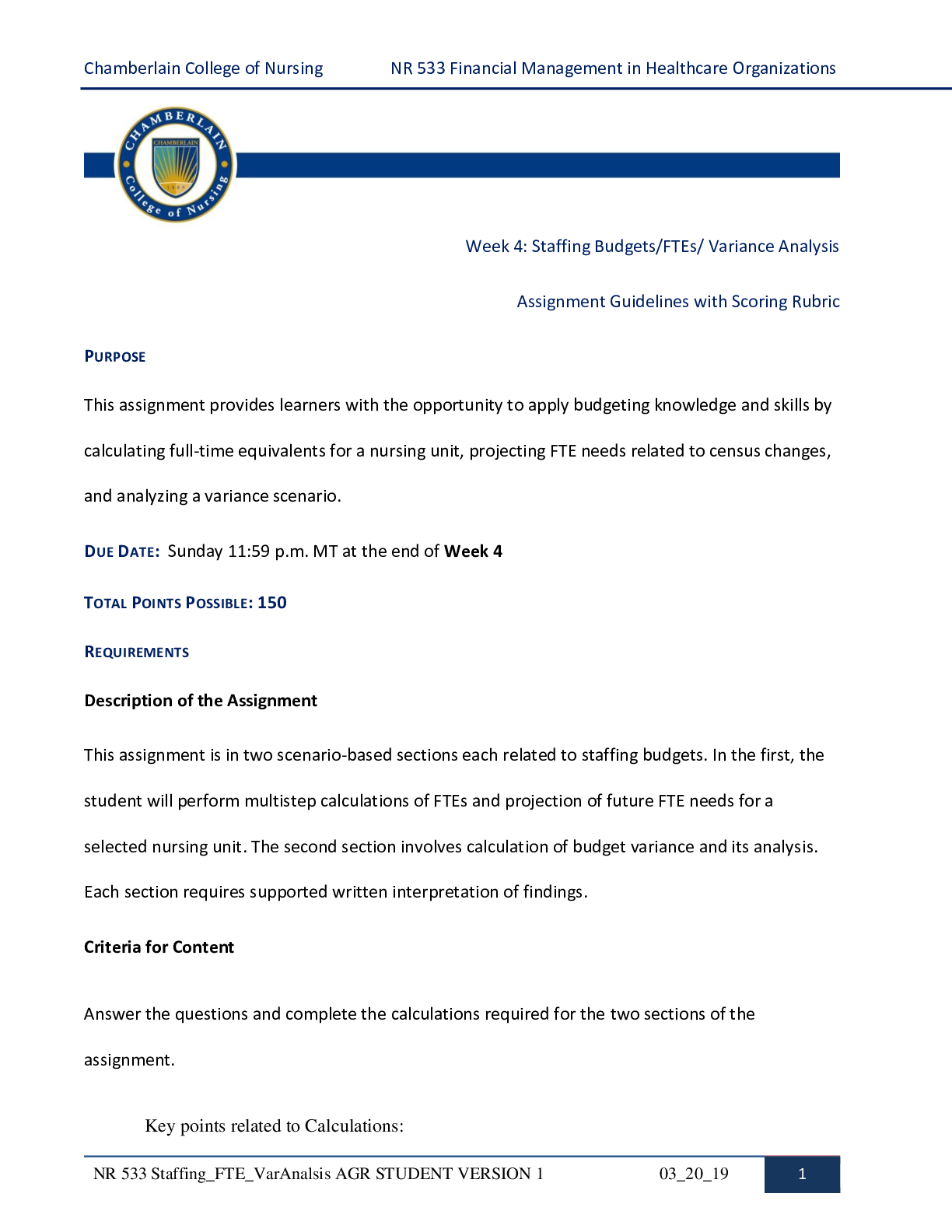
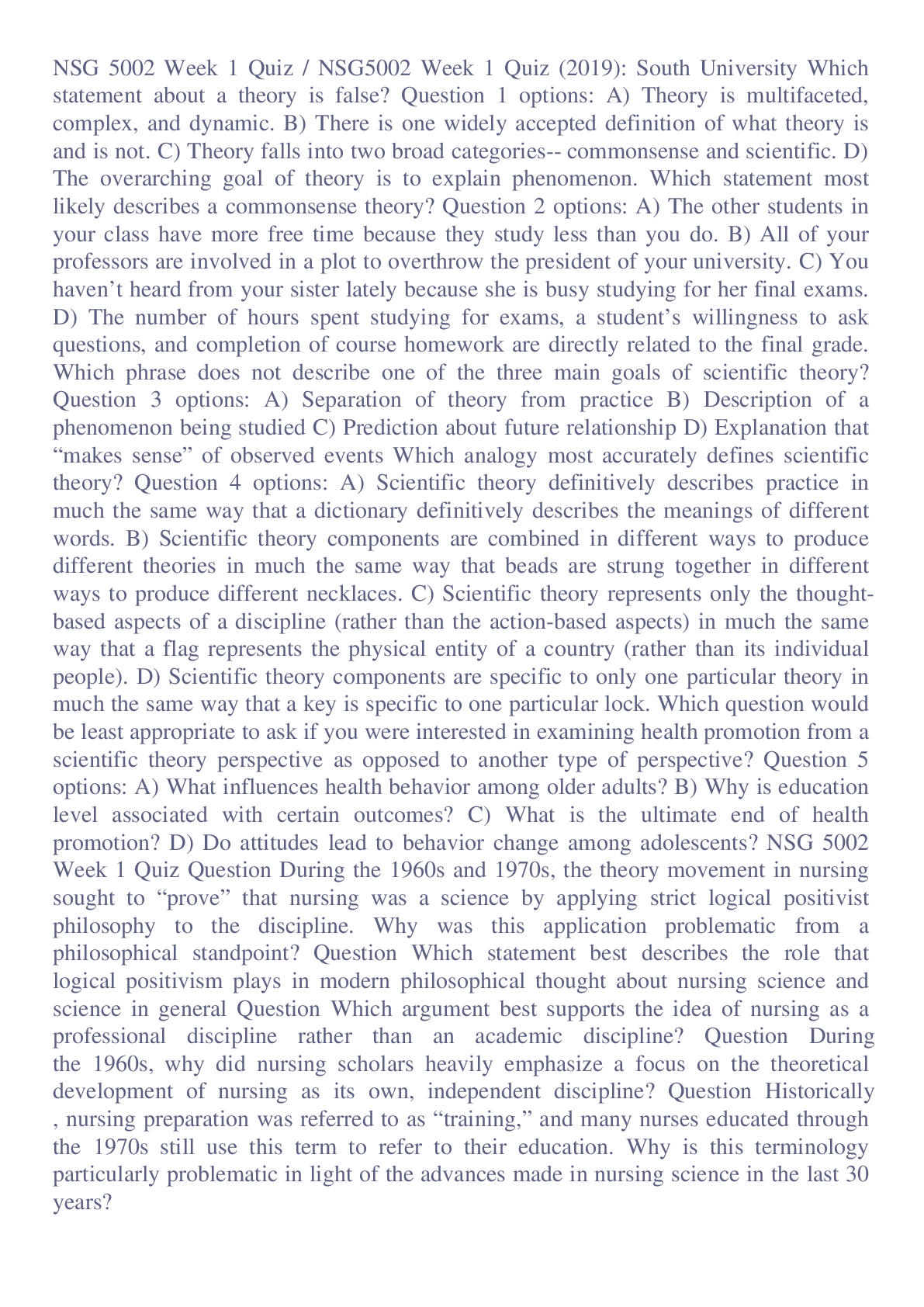
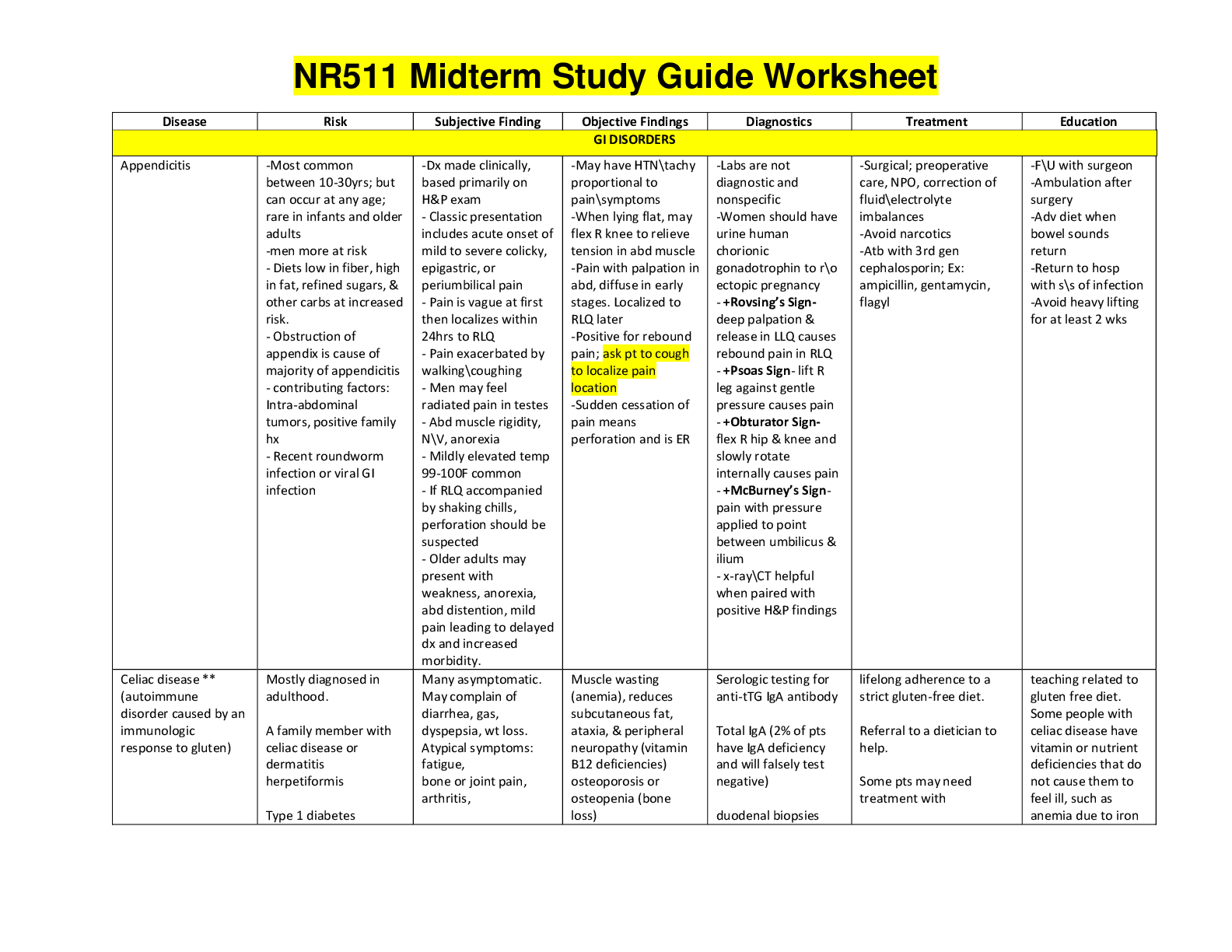
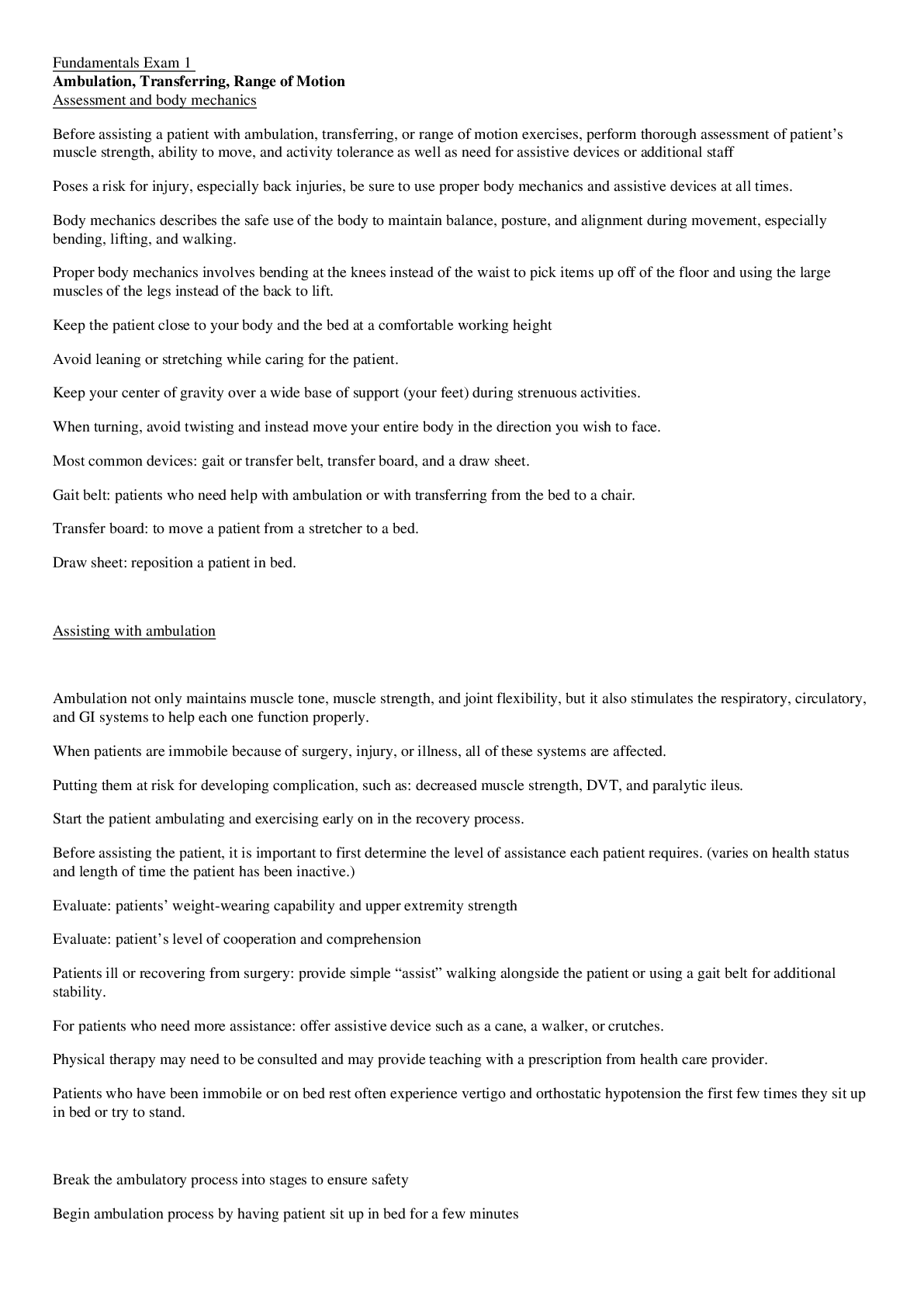

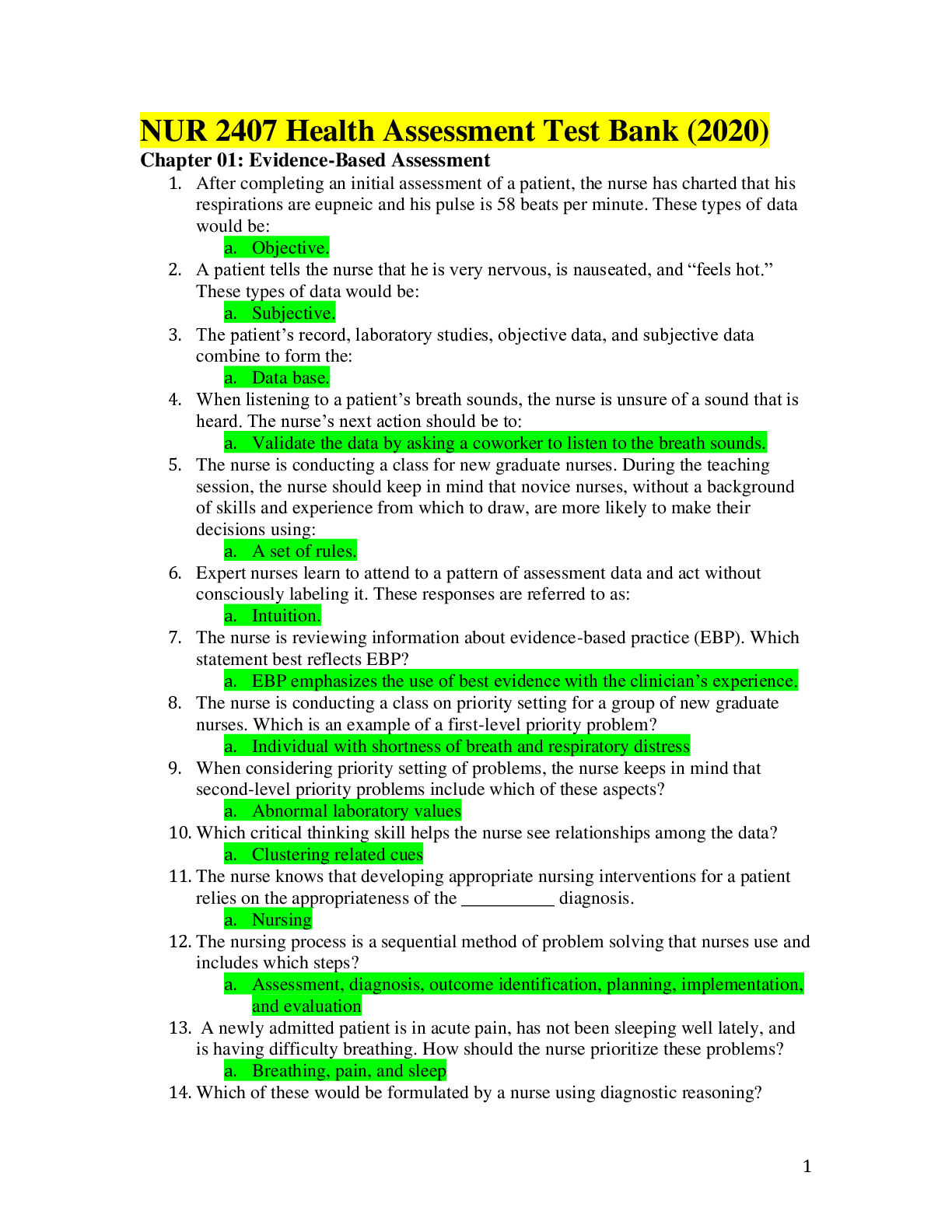
.png)
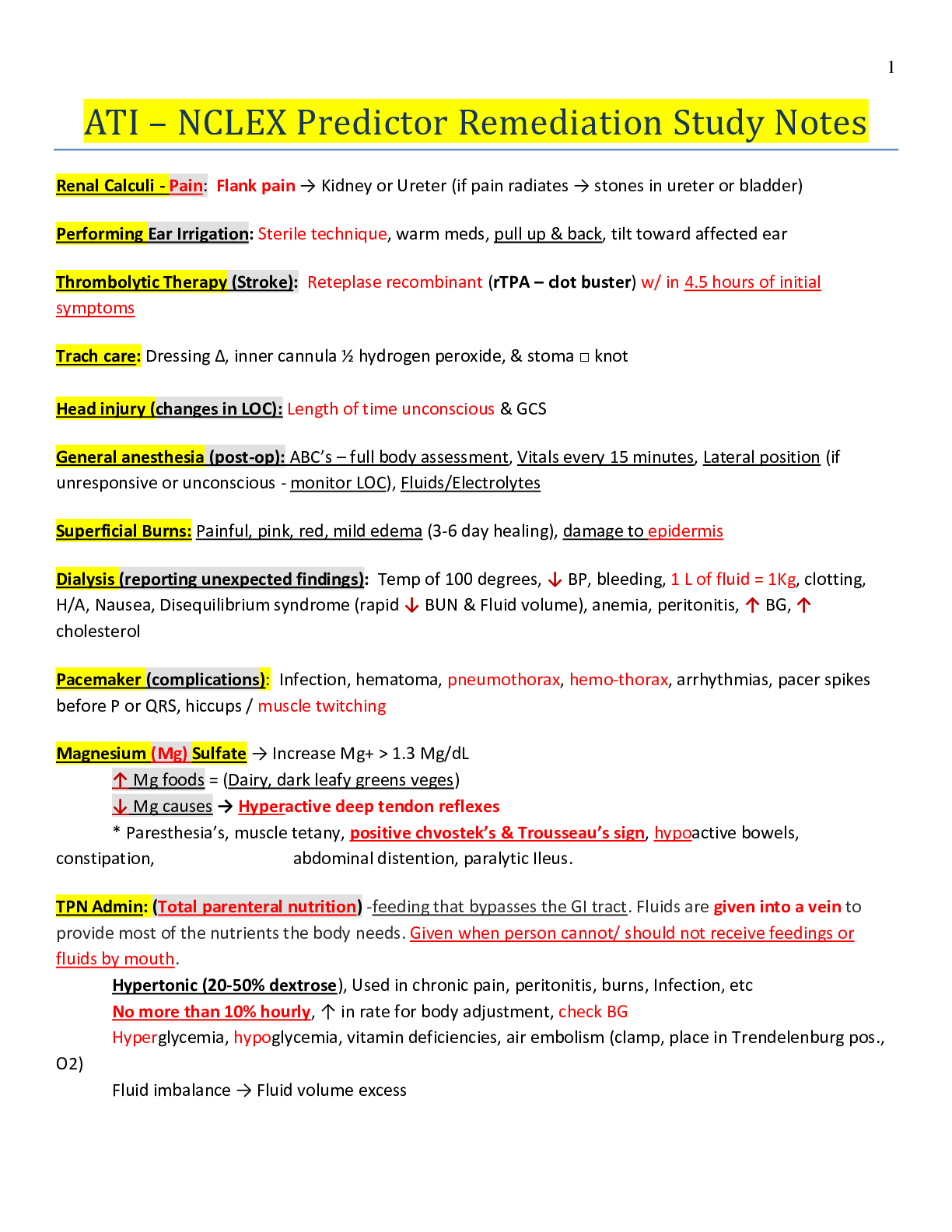
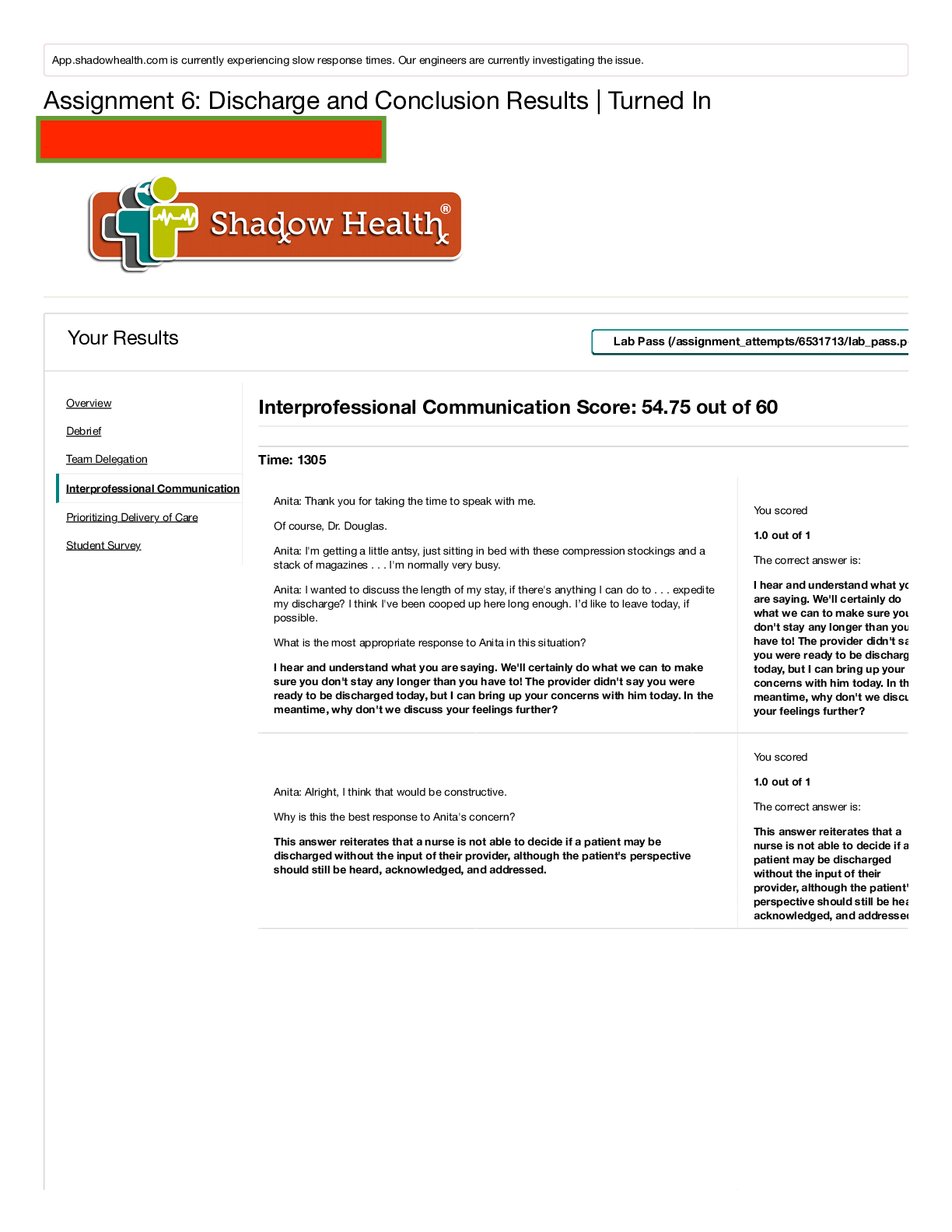
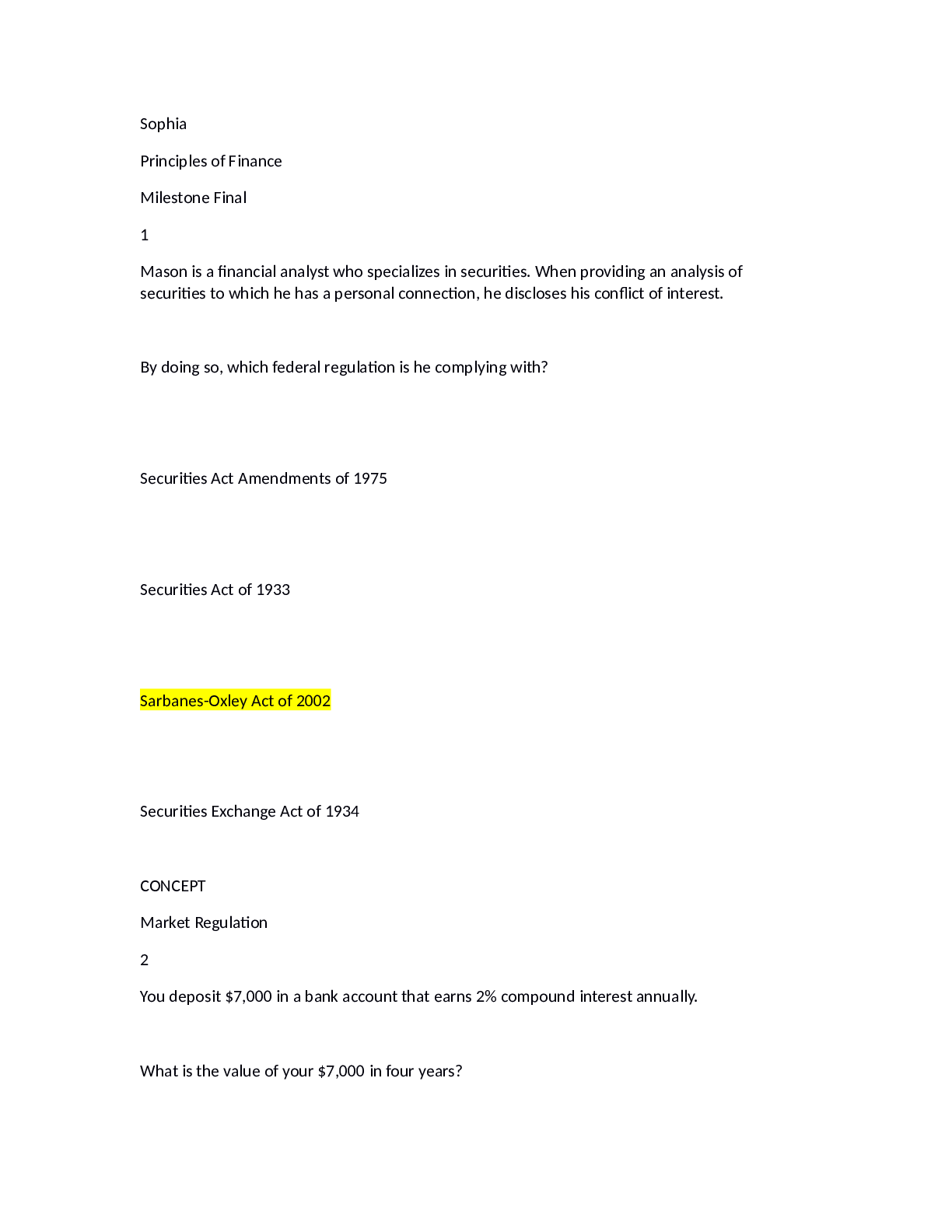
 Rasmussen College.png)
